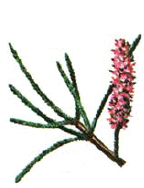BUCKWHEAT FAMILY (Polygonaceae)
SEAGRAPE (Coccoloba uvifera) has leathery, evergreen leaves, 4 to 5 inches long and 5 to 6 inches wide, smaller at growing tip. Flowers white, produced singly or in fascicles and in racemes 5 to 15 inches long. Grapelike fruits greenish white to purple. Grows to 45 feet tall and 1.5 feet in diameter; bark smooth, gray to mottled brown. On sandy shores.

PIGEON-PLUM (Coccoloba diversifolia), or Pigeon Seagrape, has leathery, evergreen leaves, 3 to 4 inches long and 1.5 to 2.5 inches wide. Fascicles of white flowers in racemes 2 to 3 inches long; fruit dark red. Reddish-brown bark smooth, occasionally scaly. Grows 70 feet tall, 2 feet in diameter; rounded crown. In sandy soils.

FOUR-O’CLOCK FAMILY (Nyctaginaceae)
LONGLEAF BLOLLY (Guapira discolor) has evergreen leaves, 1 to 2 inches long, 0.5 to 1 inch wide. Small, greenish-yellow flowers, in loose clusters; fruits red, pulpy, 0.8 of an inch long. Bark reddish brown, scaly. A shrub or small tree to 40 feet tall and 1.5 feet in diameter.


MAGNOLIA FAMILY (Magnoliaceae)
This is a family of about 100 species of trees and shrubs that grow in the warmer parts of North America and eastern Asia. Trees in two of the 10 genera, Magnolia and Liriodendron, grow in the United States. Two species of Anis-trees (Illicium), usually shrubs but rarely trees, grow in northern Florida and on Gulf Coast.
Magnolias have unique scarlet to rust-brown aggregate fruit composed of numerous podlike follicles, each containing 1 or 2 crimson seeds that hang by slender threads when ripe. The alternate leaves, deciduous or evergreen, have short stems and smooth, usually wavy margins. A single scale covers each bud, and stipule scars encircle the twigs. Asiatic magnolias grown as ornamentals include Star Magnolia (M. stellata), Kobus Magnolia (M. kobus), and Saucer Magnolia (M. soulangeana).
SOUTHERN MAGNOLIA (Magnolia grandiflora) leaves are evergreen, leathery, oval to ovate, 5 to 10 inches long, 2 to 3 inches wide; dark, glossy green above, lighter and brown-hairy below, with short, pointed apex. Fragrant flowers, 6 to 9 inches in diameter, have 3 sepals and 6 to 12 showy white petals. Aggregate fruit, 3 to 4 inches long and about 2 inches in diameter, red to rust-brown, hairy. Bark is brownish gray and scaly. Grows 25 to 80 feet tall, 2 to 3 feet in diameter, with a pyramidal or a round-topped crown.

SWEETBAY (Magnolia virginiana) leaves are deciduous in the North, but in the South remain on tree until new foliage forms. They are 4 to 6 inches long and 1 to 3 inches wide, with a blunt-pointed apex; shiny green above, whitish below. Fragrant, cup-shaped flowers are 2 to 3 inches in diameter, with 3 sepals and 9 to 12 creamy-white, concave petals. Dark red aggregate fruit is 2 inches long and about 0.5 of an inch in diameter; not hairy. Bark light brown, scaly. Usually 10 to 30 feet tall, 1 to 1.5 feet in diameter.

CUCUMBERTREE (Magnolia acuminata) leaves are deciduous, 6 to 10 inches long and 3 to 5 inches wide, with a pointed apex; yellow-green above, paler below. Flowers, about 2 inches long, have 3 sepals and 6 greenish-yellow petals (canary yellow or orange in rare variety). Red to brown, hairless, aggregate fruit is 2 to 3 inches long, 1 inch in diameter. Bark of mature trees gray-brown, scaly. Cucumbertree grows 40 to 90 feet tall and 3 to 4 feet in diameter, with straight trunk and pyramidal crown.


UMBRELLA MAGNOLIA (Magnolia tripetala) has deciduous, broadly elliptical leaves, 18 to 20 inches long and 8 to 10 inches wide, clustered near the ends of the branches. The flowers, 6 to 10 inches in diameter, with 3 sepals and 6 or 9 narrow, concave, creamy-white petals, have an unpleasant odor. Rose-colored, hairless, aggregate fruit is 2.5 to 4 inches long. A large shrub or small tree, 10 to 35 feet tall and 1 to 1.5 feet in diameter, Umbrella Magnolia is typical of moist places.

BIGLEAF MAGNOLIA (Magnolia macrophylla) has huge, deciduous leaves, 20 to 30 inches long and 8 to 10 inches wide, often widest above the middle; apex rounded or bluntly pointed, the narrowed base shallowly lobed. Fragrant, cup-shaped flowers are 10 to 12 inches in diameter, with 3 sepals, which later turn dull yellow, and 6 creamy-white petals, with rose at base. Ovoid, aggregate fruit, 2.5 to 3 inches long, is rose-colored and hairy. Grows 30 to 50 feet tall and 1 to 1.5 feet in diameter, with a round-topped crown of wide-spreading branches. The bark is gray and often scaly on older trees. Tree is rare and hard to find.

ASHE MAGNOLIA (Magnolia ashei) resembles Bigleaf Magnolia but has shorter, broader leaves, smaller flowers, and longer (to 5 inches), more cylindrical fruit. Rarely grows to small tree size.

FRASER MAGNOLIA (Magnolia fraseri) leaves are deciduous, 10 to 12 inches long, 6 to 7 inches wide; widest above the middle, with bluntly pointed apex and conspicuous, earlike lobes at the narrowed base. Fragrant flowers, 8 to 10 inches in diameter, have 3 sepals (falling soon after opening of flower) and 6 or 9 pale-yellow petals. Rose-red, hairless, oblong, aggregate fruit is 4 to 5 inches long and 1.5 to 2 inches in diameter. Grows 30 to 40 feet tall and 1 to 1.5 feet in diameter. Bark brown, scaly, or warty.

PYRAMID MAGNOLIA (Magnolia pyramidata) leaves are similar to Fraser Magnolia’s but smaller, 5 to 9 inches long and 3 to 5 inches wide. Flowers, 3 to 4 inches in diameter, have 3 sepals and 6 or 9 creamy-white petals. Rose-colored, oblong, aggregate fruit is 2 to 2.5 inches long and 1 to 1.5 inches in diameter. Grows 20 to 30 feet tall. 1 to 2 feet in diameter.
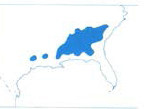
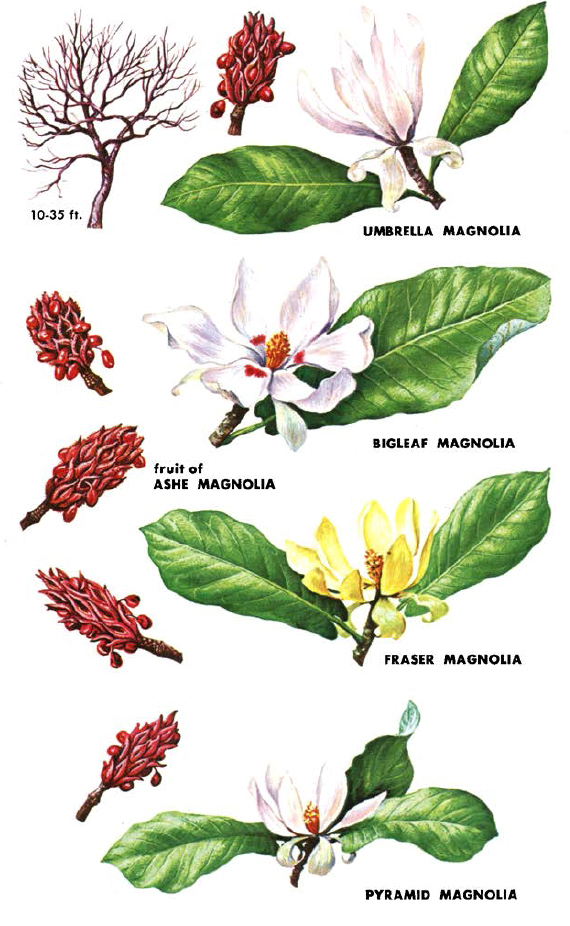
YELLOW-POPLAR (Liriodendron tulipifera), also called Tuliptree, has long-stemmed, 4-lobed, deciduous leaves, with a tulip-like outline. They are 4 to 6 inches long, bright green above and paler below. The tulip-shaped flowers, 1.5 to 2 inches in diameter, have 6 greenish-yellow petals with orange at base. They do not appear until well after the leaves develop. Fruit is a conelike aggregate of single-winged samaras, which fall apart when mature. Buds have two valvate scales, and stipule scars encircle the twigs. Mature trees have gray-brown, ridged, and furrowed bark. One of the largest of eastern hardwoods, grows 80 to 150 feet tall and 4 to 6 feet in diameter, usually with a straight, clear trunk and pyramidal crown.

CUSTARD-APPLE (ANNONA) FAMILY (Annonaceae)
This is a large (70 genera and about 600 species), primarily tropical family of deciduous and evergreen trees and shrubs with two representatives in United States. Leaves simple, alternate.
PAWPAW (Asimina triloba) leaves are deciduous, 10 to 12 inches long and 4 to 6 inches wide, widest above the middle. The apex is pointed, the margins smooth. Flowers, about 2 inches in diameter, have 3 green sepals and 6 heavily veined, purple petals in two ranks. Fruit irregularly oblong, to 5 inches long and 1.5 inches thick, with a yellow to dark-brown rind enclosing the white to yellow flesh and flat, dark-brown seeds. Edible when ripe. Blotched, gray-brown bark is thin and smooth to warty. A large shrub or small tree, 20 to 30 feet tall and 6 to 15 inches in diameter.

POND-APPLE (Annona glabra) leaves are leathery, oblong to elliptical, 3 to 5 inches long and 1.5 to 2 inches wide, with smooth margins and a pointed apex. They are bright green above, paler below, and are shed late in the fall. The flowers, about an inch in diameter, have 6 dull yellowish-white petals. The fleshy, aromatic, yellowish-brown, compound fruit is somewhat heart-shaped, 3 to 5 inches long and 2 to 3.5 inches in diameter with light-green, insipid flesh. Bark is thin, reddish brown, sometimes scaly. Small to medium-sized, 30 to 35 feet tall and 1 to 2 feet in diameter. Trunk short, usually buttressed base, and a spreading crown of somewhat twisted branches.
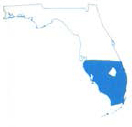

LAUREL FAMILY (Lauraceae)
Deciduous and evergreen trees and shrubs, usually with alternate leaves, are included in the more than 1,000 species of this primarily tropical family. Many have aromatic leaves, bark, twigs, and roots, providing cinnamon, camphor, and various oils used in drugs, soaps, and perfumes. Also included are the Avocado (Persea americana) and several important timber trees. Stinkwood (Ocotea bullata), of South Africa, and the Walnut Bean (Endriandra palmerstonii), of eastern Australia, furnish beautiful cabinet woods. Camphor-tree (Cinnamomum camphora), a source of commercial camphor, is grown as an ornamental in California and in southern United States, where it has escaped cultivation and grows wild. Greenheart (Nectandra rodioei) is used in marine construction; a related, native species, Jamaica Nectandra or Lancewood (N. coriacea), is common along the Florida coast.
SASSAFRAS (Sassafras albidum) has deciduous leaves, 4 to 6 inches long and 2 to 4 inches wide. Both elliptical or 2- to 3-lobed leaves may occur on same tree; turn yellow to red in fall. Dioecious; the small, yellow-green flowers in loose racemes appear with leaves in spring. Stalked, ovoid fruits, about 0.3 of an inch long, are blue with a hard seed enclosed in thin flesh. Aromatic leaves, bark, twigs, and roots yield oils used in soaps. Sassafras tea, a “spring tonic” of bygone years, is made by boiling roots or bark. Commonly grows 20 feet tall, rarely to 50 feet, with a diameter of nearly 3 feet. Often forms dense, shrubby thickets.

CALIFORNIA-LAUREL (Umbellularia californica) leaves are evergreen, lanceolate to elliptical, 2 to 5 inches long and 0.5 to 1.5 inches wide; aromatic when crushed. Loose axillary clusters of small, yellowish-green flowers appear in winter or early spring. Fruit greenish to purple, about 1 inch long. Bark greenish brown, smooth to scaly. Usually a shrub or small tree, rarely to 80 feet tall. Also called Oregon-myrtle.

REDBAY (Persea borbonia) has aromatic, evergreen leaves, 3 to 4 inches long and 1 to 1.5 inches wide. These are the bay leaves used as herbs. The creamy-white, bell-shaped flowers lack petals but have hairy sepals; they occur in loose axillary clusters. Blue to violet-black, ovoid fruit is 0.5 of an inch in diameter. Usually in moist soils near streams or swamps. To 60 feet tall.


WITCH-HAZEL FAMILY (Hamamelidaceae)
About 100 species of deciduous trees and shrubs make up the witch-hazel family. Species are found in North America, South Africa, Madagascar, Australia, and Asia. One tree-sized species and a half dozen shrubs, several of which occasionally reach tree height, are native to eastern United States and southeastern Canada.
SWEETGUM (Liquidambar styraciflua) has distinctive star-shaped leaves, alternate, 5 to 7 inches wide and with 5 to 7 pointed lobes, with toothed margins. They are bright green, turning a brilliant red-and-gold in fall. Staminate and pistillate flowers are in separate, headlike clusters on same tree—the staminate in racemes, pistillate solitary. Fruit is a long-stemmed, woody, burlike head of capsules, 1.5 inches in diameter; each capsule contains two small seeds. Twigs often have corky wings. Grows 80 to 120 feet tall and 3 to 5 feet in diameter, with gray to brown, ridged and furrowed bark. Wood used for furniture, veneer, interior trim, and novelties.
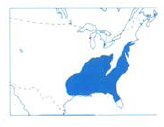
WITCH-HAZEL (Hamamelis virginiana) leaves are alternate, 4 to 6 inches long and 2 to 3 inches wide, their greatest width above the middle. Leaves have deep, widely spaced, rounded marginal teeth and a lopsided base; dull green above and lighter below, with hairs along midrib and veins; turn delicate yellow in autumn. Flowers with 4 narrow, yellow petals appear in fall or winter. They produce a 2-beaked, woody capsule, 0.5 of an inch long, which splits open when mature and forcefully ejects lustrous black seeds. A shrub or a small tree, to 30 feet tall and 12 inches in diameter, usually in moist soils near streams.

CAPER FAMILY (Capparidaceae)
JAMAICA CAPER (Capparis cynophallophora) leaves are evergreen, alternate, 2 to 3 inches long and 1 to 1.5 inches wide, with smooth margins and a rounded or notched apex. They are yellow-green above, with fine brownish scales below. Flowers, 1.3 inches across, have 4 scaly sepals, 4 petals (at first white, becoming purple), and a tuft of purple stamens 1 to 2 inches long with yellowish-orange anthers. Podlike fruit, 9 to 10 inches long, is constricted between seeds. To 20 feet tall, usually in sandy tidewater soils. Limber Caper (C. flexuosa) is similar, with lighter leaves; less commonly tree size.


SYCAMORE FAMILY (Platanaceae)
This is a family of only one genus containing about six species, the sycamores, or planetrees. Three species are native to the United States. The other three are found in Mexico, Central America, southwestern Asia, and southeastern Europe. All have deciduous, alternate, palmately lobed leaves, usually with a hairy undersurface. Under the hollow, enlarged base of each leaf stem is a shiny-brown, conical bud covered by a single caplike scale. When the leaves fall, the buds are exposed, completely encircled by the leaf scar. Staminate and pistillate flowers are in separate globular heads on the same tree. The unique multiple fruit, commonly called button-balls, consists of many tiny, elongated seeds with upright hairs at the base. The fruit breaks apart when ripe. Sycamore bark peels in thin, irregular patches giving the trunks a whitish-brown appearance. The twigs, encircled by stipule scars, have a distinctive zigzag form. Sycamores are typical of moist soils and are common along streams. They grow well in a variety of conditions, however, and are used as shade and street trees.
AMERICAN SYCAMORE (Platanus occidentalis) leaves are broadly ovate, 4 to 8 inches wide, and shallowly 3- to 5-lobed, the lobes with large marginal teeth. Globular heads of seeds, 1 to 1.5 inches in diameter, hang singly on slender stems 3 to 6 inches long. American Sycamore is a massive tree, frequently attaining a height of 100 feet and a diameter of 3 to 10 feet, with a wide-spreading crown.
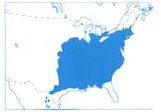
CALIFORNIA SYCAMORE (Platanus racemosa) leaves are 6 to 10 inches wide, with 3 to 5 lobes that are longer than broad; margins toothed (occasionally smooth). Globular seed heads, to 1 inch in diameter, are in racemes of 3 to 7. California Sycamore grows 40 to 90 feet tall and 1 to 3 feet in diameter.

ARIZONA SYCAMORE (Platanus wrightii) is similar to California Sycamore, but its leaves are often 7-lobed and the globular seed heads are in racemes of 2 to 4.

INTRODUCED SYCAMORES
ORIENTAL PLANETREE (Platanus orientalis) resembles American Sycamore but has smaller, more deeply lobed leaves. Seed heads are in strings of 2 to 4. London Planetree (P. acerifolia), a hybrid between American Sycamore and Oriental Planetree, has leaves like American Sycamore; seed heads like Oriental Planetree’s. Bark greenish brown.

ROSE FAMILY (Rosaceae)
This large, diversified family contains more than 3,000 species of trees, shrubs, and herbaceous plants, most abundant in temperate regions. Their perfect flowers typically have 5 sepals and 5 petals. Among familiar members are apples, cherries, plums, peaches, pears, apricots, almonds, strawberries, raspberries, and blackberries. Important ornamentals include the roses, spireas, hawthorns, firethorns, and mountain-ashes.
APPLES (Malus)
About 25 species of apples are native to temperate regions of the Northern Hemisphere; five native North American species are included here. All are small trees or occasionally shrubs, their leaves deciduous, alternate, and toothed or less commonly lobed. Apple blossoms, usually fragrant, are white to pink and 1 to 1.5 inches in diameter. They are clustered in racemes on short, spurlike branches. The fruit (a pome) of native species is much smaller than the fruit of commercially grown varieties.
Numerous varieties of apples have been developed from Malus pumila, the common native apple of southeastern Europe and central Asia. This species was introduced into North America by early settlers and is now naturalized in many parts of the United States and Canada. Its toothed, ovate to elliptical leaves have white hairs on the underside and on the stems. Other species with showy flowers or attractive fruits are planted as ornamentals.
SOUTHERN CRAB APPLE (Malus angustifolia) leaves are elliptical to ovate, 1 to 3 inches long and 0.5 to 2 inches wide. They have toothed margins, a wedge-shaped base, and blunt to pointed apex. Fragrant, pinkish flowers, about 1 inch in diameter, are in clusters of 3 to 5. The apples are pale yellow-green, broader than long, and about 1 inch in diameter. A shrub or small tree, to 30 feet tall and 10 inches in diameter, with a broad, open crown of stiff branches.

SWEET CRAB APPLE (Malus coronaria) leaves are 2 to 3 inches long and 1.5 inches wide. Oval to ovate, with a rounded to abruptly pointed apex, usually a rounded base, and toothed margins. The fragrant, pinkish-white flowers, to 1.5 inches in diameter, are in clusters of 3 to 6. The yellow-green fruit is about an inch in diameter and broader than long. Grows as a shrub or small tree, often forming thickets in moist soils. The twigs are armed with sharp spines.
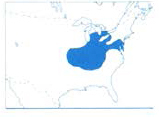

BILTMORE CRAB APPLE (Malus glabrata) is considered synonymous with Sweet Crab Apple in 1979 Checklist (see here). Roughly triangular leaves, 2.5 to 3.5 inches long, 2 to 2.5 inches wide, have 3 to 5 coarsely toothed, pointed lobes. Flowers 4 to 7 per cluster. Fruit, about 1.5 inches in diameter, ribbed at apex. Twigs often with spines to 1.5 inches long. Shrub or small tree to 25 feet tall.
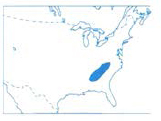
PRAIRIE CRAB APPLE (Malus ioensis) leaves, usually hairy below, are 2 to 4 inches long, 1 to 1.5 inches wide. The rosy-white flowers, 1.5 to 2 inches in diameter, occur in clusters of 3 to 6 and the greenish-yellow fruit is about 1.3 inches in diameter. Grows as a shrub or a small bushy tree, to 30 feet tall.

OREGON CRAB APPLE (Malus fusca) leaves are ovate to elliptical, 1 to 4 inches long, 0.5 to 1.5 inches wide, occasionally 3-lobed; base wedge-shaped or rounded. White flowers, about 0.8 of an inch in diameter, occur in clusters of 4 to 10. Oblong, yellow-green to reddish-purple apples are 0.5 to 0.8 of an inch long. Oregon Crab Apple may form thickets in moist soil; it grows to 40 feet tall.
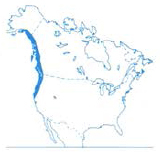
MOUNTAIN-ASHES (Sorbus)
About 80 species of small, deciduous trees and shrubs of cooler parts of the Northern Hemisphere are known as mountain-ashes; not related to ashes. Mountain-ashes have pinnately compound, alternate leaves, flat-topped clusters (cymes) of small, white flowers that develop after leaves appear, and small, apple-like, red or orange fruits. In North America, only eastern species reach tree size.
AMERICAN MOUNTAIN-ASH (Sorbus americana) leaves are 6 to 8 inches long, with 13- to 17-toothed, lanceolate leaflets 2 to 4 inches long, 0.3 to 1 inch wide, toothed above middle; turn yellow in fall. To 30 feet tall; bark light gray-brown, smooth to scaly. The smaller Showy Mountain-ash (S. decora), in the same area, has 7 to 13 broader leaflets, with larger flowers and fruits. Sitka Mountain-ash (S. sitchensis), of northwestern North America, rarely reaches tree size.

EUROPEAN MOUNTAIN-ASH (Sorbus aucuparia) is similar to American Mountain-ash but has smaller, bluntly pointed leaflets, 0.8 to 2 inches long and 0.5 to 0.8 of an inch wide, often somewhat hairy below. Also called Rowan Tree, it occurs in several varieties and is planted widely as an ornamental in North America.

CHERRIES AND PLUMS (Prunus)
Widely distributed in cool parts of the Northern Hemisphere, cherries and plums produce delicious fruits, are prized as ornamentals, and, in some cases, are valuable for their beautiful wood. All have simple, alternate leaves, usually with serrate margins. The fruit is a drupe and bark gives off an acid smell when scraped. Most cultivated cherries and plums originally come from Europe; ornamental flowering species from Asia. Several introduced species have escaped cultivation and are now naturalized in eastern North America. These include Mazzard Cherry (P. avium), Sour Cherry (P. cerasus), Golden Plum (P. domestica), Bullace Plum (P. insititia), Mahaleb Cherry (P. mahaleb), Peach (P. persica), and Sloe or Blackthorn (P. spinosa). Apricots and almonds also belong to this genus. Desert Apricot (P. fremontii), native to Southern California, is most commonly a shrub, rarely a tree.
BLACK CHERRY (Prunus serotina) has narrowly oval to oblong-lanceolate, deciduous leaves, 2 to 6 inches long and 1 to 1.5 inches wide, with fine marginal teeth. White flowers, about 0.3 of an inch in diameter, in racemes 4 to 6 inches long. Fruit 0.5 of an inch in diameter, black with dark-purple flesh. Satiny, reddish-brown wood prized for fine furniture. Grows 50 to 60 feet tall, 1 to 3 feet in diameter. Bark of young trees smooth, dark reddish brown to black, and marked with horizontal lenticels (raised, warty patches); scaly on large trees.

PIN CHERRY (Prunus pensylvanica) has oblong-lanceolate leaves, 3 to 4 inches long and 0.8 to 1.3 inches wide, with small marginal teeth. Creamy-white flowers, about 0.5 of an inch in diameter and 4 to 5 per cluster (umbels or corymbs), appear with or after leaves. Bright-red cherries, 0.3 of an inch in diameter, have acid taste. Bark smooth, reddish brown, with horizontal lenticels; later in broad plates. Grows 15 to 25 feet tall, 18 to 20 inches in diameter.

COMMON CHOKECHERRY (Prunus virginiana) has broadly obovate leaves, 2 to 4 inches long and 1 to 2 inches wide; apex pointed; margins often doubly toothed. White flowers, 0.5 of an inch in diameter, in racemes 3 to 6 inches long. Astringent, dark-red cherries are 0.3 of an inch in diameter. Lustrous-brown bark, with pale lenticels, is ill-smelling; later becomes scaly. A bushy tree, Common Chokecherry grows to 25 feet tall and 8 inches in diameter.


BITTER CHERRY (Prunus emarginata) has elliptical or oblong-obovate leaves, 1 to 3 inches long and 0.5 to 1.5 inches wide, with toothed margins. White flowers, 0.5 of an inch across, are in 6- to 12-flowered corymbs; appear when leaves are about half grown. Red to black cherries, about 0.5 of an inch in diameter, have thin, astringent flesh. Bark brownish, with horizontal, orange lenticels. Bitter Cherry grows 30 to 40 feet tall and 1 to 1.5 feet in diameter, forming an oblong crown.

CATALINA CHERRY (Prunus lyonii) leaves are evergreen, ovate to lanceolate, 2 to 4 inches long and 0.5 to 2.5 inches wide; margins are smooth, thickened and wavy, occasionally sparingly toothed. White flowers, about 0.3 of an inch across, are in racemes 3 to 4 inches long. Dark-purple to black cherries, about 1 inch in diameter, have thick, delicious flesh. A bushy tree, 25 to 30 feet tall and 1 to 3 feet in diameter, with a compact crown and reddish-brown bark.

WEST INDIES CHERRY (Prunus myrtifolia) leaves are evergreen, elliptical to oblong-ovate, 2 to 4.5 inches long and 1 to 1.5 inches wide, with smooth margins. White flowers with yellow at base of the petals are 0.1 of an inch in diameter. They appear late in fall, in short racemes. Fruit is orange-brown, nearly round, 0.3 to 0.5 of an inch in diameter, with thin, dry flesh. West Indies Cherry grows to 45 feet tall and 6 inches in diameter.

CAROLINA LAURELCHERRY (Prunus caroliniana) leaves are evergreen, oblong-lanceolate, 2 to 5 inches long and 0.8 to 1.5 inches wide; smooth or sparingly toothed margins. Short racemes of cream-white flowers appear in late winter or early spring. Oblong fruit, about 0.5 of an inch in diameter, is nearly black, with thin, dry flesh. Gray bark is at first smooth, later roughened. Carolina Laurelcherry grows to 40 feet tall and 10 inches in diameter.

HOLLYLEAF CHERRY (Prunus ilicifolia) has ovate to ovate-lanceolate, evergreen leaves, 1 to 2 inches long and 1 to 1.5 inches wide, with coarsely toothed margins. White flowers, 0.3 of an inch in diameter, are in short racemes. Thin-fleshed fruit is nearly black and about 0.5 of an inch in diameter when they are ripe. Hollyleaf Cherry grows to 25 feet tall, with dark reddish-brown, fissured bark.
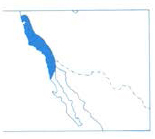

AMERICAN PLUM (Prunus americana) has oblong-ovate leaves, 3 to 4 inches long and 1.5 to 2 inches wide, with a long, tapering apex and toothed margins. The ill-smelling flowers, about 1 inch in diameter, are white with red sepals and occur in 2- to 5-flowered umbels; they appear before the leaves. The round, red fruit is about 1 inch in diameter and has tart, yellow flesh. On young trees the bark is thin, smooth, and brown; on mature trees, scaly. Grows 20 to 30 feet tall and 1 foot in diameter with a broad, spreading crown; commonly forms thickets in moist soil.
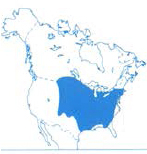
ALLEGHENY PLUM (Prunus alleghaniensis) leaves are narrowly lanceolate, 2 to 3.5 inches long and 0.8 to 1.3 inches wide, with small marginal teeth. The white flowers, 0.5 of an inch in diameter, are in 2- to 4-flowered umbels; they appear with the leaves. Globular plums, about 0.5 of an inch in diameter, are dark reddish purple with yellow flesh. A small tree to 20 feet tall, it has scaly, dark-brown bark.

FLATWOODS PLUM (Prunus umbellata) resembles Allegheny Plum, but slightly smaller leaves are oblong-lanceolate. Flowers, 1 inch in diameter, appear before leaves. The tart plums are usually purplish black, though sometimes yellow.
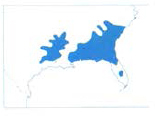
HORTULAN PLUM (Prunus hortulana) leaves are oblong-lanceolate, 4 to 6 inches long, with slender, orange stems. Flowers, to 1 inch across, have white petals with orange at the base; they appear after the leaves. Plums are red, occasionally yellowish, with thin flesh. Hortulan Plum is a small tree to 30 feet tall, with dark-brown bark.

WILDGOOSE PLUM (Prunus munsoniana) has elliptical to lanceolate leaves, 2 to 4 inches long. Flowers are white, 0.5 to 0.8 of an inch across; the red plums, with yellow flesh, are about 0.8 of an inch long. To 20 feet tall and 6 inches in diameter, usually with smooth, brown bark; twigs occasionally thorny.

CHICKASAW PLUM (Prunus angustifolia) has lanceolate leaves, 1 to 2 inches long. White flowers, 0.3 of an inch across, appear before the leaves; the red to yellow plums are 0.5 of an inch in diameter. To 25 feet tall, often with spurlike, lateral twigs on branches.


KLAMATH PLUM (Prunus subcordata) has elliptical to broadly ovate leaves, 1 to 3 inches long and 0.5 to 2 inches wide, with finely toothed margins. White flowers, 0.7 of an inch in diameter, are in 2- to 4-flowered umbels; bloom before leaves appear. The tart, dark-red or occasionally yellow plums are 0.8 to 1.3 inches long. Klamath Plum grows to 25 feet tall, with a rounded crown, gray-brown, scaly, and fissured bark. Branches are often spiny.

CANADA PLUM (Prunus nigra) leaves are oblong-ovate to obovate, 3 to 5 inches long and 1.5 to 3 inches wide, with an abrupt, narrow apex and marginal teeth. White flowers, about 1.3 inches in diameter, appear in 3- to 4-flowered umbels before or with the leaves. The yellow-fleshed, orange-red plums are 1 to 1.3 inches long. Grows 30 feet tall. Has a short trunk with gray-brown bark that peels off in layers.

MEXICAN PLUM (Prunus mexicana) has ovate to elliptical leaves, 1.8 to 3.3 inches long. White flowers, about 1 inch in diameter and in 3- to 4-flowered umbels, bloom before leaves appear. Dark purple-red plums, to 1.5 inches long, have thick, sweet flesh. To 30 feet tall, with dark-gray, scaly to fissured bark.

SERVICEBERRIES (Amelanchier)
Widely distributed throughout temperate regions, these shrubs or small trees have deciduous, simple, alternate leaves, with either toothed or smooth margins; white flowers in racemes; the nearly round, usually succulent fruit is dark blue to black.
WESTERN SERVICEBERRY (Amelanchier alnifolia) leaves are oblong to ovate, 1.5 to 2.5 inches long and 1 to 1.5 inches wide; margins usually toothed only above middle and apex is sometimes pointed. Flowers, 0.5 to 0.8 of an inch long, appear when leaves are about half grown. Fruit sweet, juicy, and succulent; dark blue with surface lightly covered by gray waxy bloom, and to 0.5 of an inch in diameter. A tall shrub or small tree, it grows to 40 feet in height and 1.5 feet in diameter. Bark dark reddish brown. Downy Serviceberry or Shadbush (A. arborea) leaves, white-hairy on underside when first developed, are usually abruptly pointed at apex; fruit dry, tasteless. Similar species include Roundleaf Serviceberry (A. sanguinea).


HAWTHORNS (Crataegus)
This very complex genus includes many species of shrubs or small, round-topped, usually thorny trees. They are most abundant in eastern North America, but nearly 100 species are found in the cooler parts of Europe and Asia. Hawthorns are easy to recognize as a group, but the species are difficult to identify. All have alternate, conspicuously toothed, sharply incised, or lobed leaves. They bear clusters of showy white, pink, or red flowers, each from 0.3 to 1 inch in diameter. The attractive, though dry and mealy, apple-like fruits, 0.3 to 0.8 of an inch in diameter, are usually red or orange but in some species are dark blue, black, or yellow. The smooth, greenish-brown bark of the branches and smaller trunks breaks up into thin, scaly plates with age. Trunks of mature trees are often fluted, or “muscular.” The wood is hard and heavy but not commercially important. Hawthorns are popular as ornamentals, and a number of horticultural varieties have been developed. Twelve of the more than 100 native North American species of hawthorns are described and illustrated here.
BLACK HAWTHORN (Crataegus douglasii) leaves are ovate to obovate, about 1 to 2 inches long and 0.5 to 1.5 inches wide, and coarsely toothed near apex. Flowers are in broad clusters. Fruits shiny black.

FROSTED HAWTHORN (Crataegus pruinosa) leaves, 1 to 1.5 inches long and 1 inch wide, have either deeply cut margins or 3 to 4 pairs of shallow lobes. Few flowers in a cluster. Dark purple-red fruit, about 0.5 of an inch in diameter, is covered with small, dull dots.

SCARLET HAWTHORN (Crataegus coccinea) leaves are broadly ovate to diamond-shaped, 3 to 4 inches long, and shallowly lobed. Many flowers per cluster. Fruits red with dark dots. Spines are 1 to 2 inches long.

COCKSPUR HAWTHORN (Crataegus crus-galli) leaves are 1 to 4 inches long and 0.3 to 1 inch wide, widest and toothed above the middle. Each of the many-flowered clusters produces oval, scarlet fruits about 0.5 of an inch long. The spines of Cockspur Hawthorn are 3 to 4 inches long.
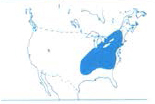
DOWNY HAWTHORN (Crataegus mollis) leaves are 3 to 4 inches long and about as wide, broadest near their base. The margins are either sharply cut or shallowly lobed. Many flowers in each cluster. Fruits scarlet; spines may be 2 inches long.


LITTLEHIP HAWTHORN (Crataegus spathulata) leaves are spatula-shaped, often 3-lobed near apex. Many flowers in each cluster. Small, scarlet fruits are about 0.1 of an inch in diameter. Spines 1 to 1.5 inches long.

BLUEBERRY HAWTHORN (Crataegus brachycantha) leaves, 1 to 2 inches long, are usually widest near the rounded apex, with rounded marginal teeth. Flowers white, fading to orange. Fruit bright blue. Spines less than 1 inch long. Usually small but may grow to 50 feet tall.

BILTMORE HAWTHORN (Crataegus intricata) leaves are broadly ovate, toothed, occasionally lobed near the apex. Flowers in clusters of 4 to 10. Fruit yellowish red, about 0.5 of an inch in diameter. Spines to 2 inches long. A shrub or small tree.

TURKEY HAWTHORN (Crataegus induta) is similar to and considered synonymous with Downy Hawthorn in 1979 Checklist (see here). It occurs farther south than Downy Hawthorn, usually in dry upland woods.

BARBERRYLEAF HAWTHORN (Crataegus berberifolia) leaves are oblong-obovate, to 2 inches long, hairy below. Flowers 4 to 5 in a cluster; fruits orange, about 0.5 of an inch in diameter. Spines 1 to 1.5 inches long.

PARSLEY HAWTHORN (Crataegus marshallii) leaves are broadly ovate to orbicular, with 5- to 7-toothed lobes. The many-flowered clusters produce oblong, scarlet fruits 0.3 of an inch long. The spines are 1 to 1.5 inches long.

WILLOW HAWTHORN (Crataegus saligna) leaves are narrowly oval, 1.5 to 2 inches long, and toothed toward apex; turn red in fall. Globose fruit, 0.8 of an inch in diameter, is first red, later turning black.

SOME INTRODUCED HAWTHORNS
ENGLISH HAWTHORN (Crataegus oxyacantha) leaves are broadly ovate, with 3 to 5 shallow lobes. Flowers red or white. Bright-red fruit contains two seeds. Native to Europe and northern Africa.
ONE-SEED HAWTHORN (Crataegus monogyna) resembles English Hawthorn, but leaves have 3 to 7 lobes, often with smooth margins. Fruits have one seed. Native to Europe, northern Africa, western Asia.

CERCOCARPUS OR MOUNTAIN-MAHOGANY (Cercocarpus spp.)
These shrubs or small trees are found in the dry, mountainous regions of western North America. Their leaves are simple, alternate, leathery, and either deciduous or evergreen, with either smooth or toothed margins. Flowers are solitary or clustered on short, lateral branchlets. They lack petals, and the greenish-white sepals form an elongated tube, expanded into a 5-lobed cup at the apex. Each flower produces a dry, leathery fruit that has a twisted, feathery plume at its apex. All have scaly bark and stiff branches.
BIRCHLEAF CERCOCARPUS (Cercocarpus betuloides) has obovate to oval leaves, 1 to 1.3 inches long and 0.3 to 0.5 of an inch wide, with rounded, toothed apex and wedge-shaped base. Dark green above; paler, often hairy below. Flowers 1 to 3 per cluster. A shrub or small tree to 25 feet tall; several varieties.

HAIRY CERCOCARPUS (Cercocarpus breviflorus) leaves are oblong to nearly elliptical, 0.5 to 1 inch long and 0.3 to 0.5 of an inch wide. They are gray-green, with rounded teeth near the apex, and hairy below. Flowers 1 to 3 per cluster. A shrub or small tree, to 15 feet tall and 5 inches in diameter, with erect branches forming an irregular, spreading crown.
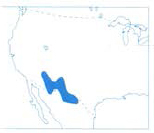
CURLLEAF CERCOCARPUS (Cercocarpus ledifolius) has narrow, lanceolate leaves, 0.5 to 1 inch long and 0.3 to 0.8 of an inch wide, with smooth, curled-under margins. They are dark green above and hairy below. Flowers usually solitary. A shrub or small tree, to 25 feet tall and to 2 feet in diameter; branches stout, spreading.
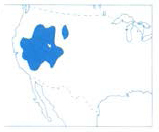
MEMBERS OF MISCELLANEOUS GENERA IN THE ROSE FAMILY
TOYON (Heteromeles arbutifolia) has alternate, oblong to elliptical, evergreen leaves, 3 to 4 inches long and 1 to 1.5 inches wide, with prominent marginal teeth. The white flowers occur in terminal clusters, 4 to 6 inches across. They develop somewhat pear-shaped, scarlet (rarely yellow) fruit, about 0.3 of an inch long. They ripen from October to December. Toyon grows as a shrub or small tree, to 30 feet tall and 1.5 feet in diameter, with gray bark and a narrow, round-topped crown of erect branches.


COCOPLUM (Chrysobalanus icaco) leaves, 1 to 3.5 inches long and 1 to 2.3 inches wide, are alternate, broadly elliptical to obovate leathery, evergreen, and smooth-margined. White flowers are in clusters 1 to 2 inches long. Fruit, 1.5 to 1.8 inches in diameter, is pink, yellow, or creamy, with thick, white, juicy flesh. The reddish-brown bark is scaly. Usually a shrub, often forming thickets in moist soils, but may grow to small-tree size (10 to 12 feet), with erect branches. The similar Everglades Cocoplum (C. icaco var. pellocarpus) occurs farther south.
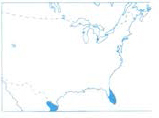
LYONTREE (Lyonothamnus floribundus) has opposite, evergreen leaves, often of two types: simple and lanceolate, 4 to 8 inches long and 0.5 of an inch wide, with smooth or toothed margins; or pinnately compound, 3 to 6 inches long, with 3 to 7 leaflets. White flowers, 0.3 of an inch across, are in terminal clusters 4 to 8 inches broad, each flower producing a conical, woody carpel about 0.3 of an inch long. The dark reddish-brown bark peels into thin, papery strips. A small tree, often with several stems, but occasionally with a single trunk; to 40 feet tall and 10 inches in diameter. Grows in dry soils.

TORREY VAUQUELINIA (Vauquelinia californica) has leathery, usually alternate, lanceolate leaves, 1.5 to 3 inches long and 0.3 to 0.5 of an inch wide, with toothed margins and hairy below. Remain on the tree through the first winter after they form. White flowers, about 0.3 of an inch in diameter, occur in terminal clusters 2 to 3 inches across. Each produces a hairy, woody, ovoid capsule about 0.3 of an inch long. Grows in dry or rocky soils, as a shrub or a small tree, with scaly, reddish-brown bark. To 20 feet tall, 6 inches in diameter.

CLIFFROSE (Cowania mexicana) has wedge-shaped leaves less than 1 inch long, divided into 3 to 5 narrow lobes. Leathery, hairy below, and covered with resinous specks, they usually persist through the first winter. The white to pale-yellow flowers, about 1 inch in diameter, develop into a dry fruit with feathery plumes about 2 inches long. Usually a shrub but occasionally a small tree, to 25 feet tall and 8 inches in diameter, with stiff, erect branches. It has gray, scaly bark and grows in dry, rocky soils.


LEGUME FAMILY (Leguminosae)
This family contains more than 500 genera and about 13,000 species of herbs, vines, shrubs, and trees found throughout the world. Many species have thorny branches. Leaves are alternate, compound in most. Some shed their leaves; others are evergreen. All produce a legume, or pod. Clover, alfalfa, peas, and beans are important legume crops. Other species are well-known ornamentals. Some, especially tropical trees, yield wood, dyes, and similar porducts. Nitrogen-fixing bacteria in root nodules of legumes aid in enriching the soil.
Tesota or Desert-ironwood (Olneya tesota) is native to southwestern United States and Mexico. Silktree, or Mimosa-tree (Albizia julibrissin), native to southern Asia, is an ornamental in parts of the United States where it now also grows wild. The similar Lebbek, or Woman’s Tongue (A. lebbek), is common in southern Florida, as are Flamboyant-tree, or Royal Poinciana (Delonix regia), a native of Madagascar; Flower-fence, or Dwarf Poinciana (Poinciana pulcherrima); and Tamarind (Tamarindus indica), of the Old World tropics. Paradise Poinciana (P. gilliesii), of South America, is naturalized in the Southwest.
BLACKBEADS (Pithecellobium spp.) are shrubs or small trees, to 30 feet tall. Bipinnately compound leaves are evergreen or tardily deciduous; twigs spiny. Catclaw Blackbead (P. unguis-cati) has one pair of leaflets on its two pinnae; flowers in globular heads; pods contorted. Huajillo (P. pollens) has many small leaflets on 8 to 10 pinnae; flowers in globular heads, pods straight and flat. Ebony Blackbead (P. flexicaule) has several leaflets on 4 to 6 pinnae, light-yellow flowers in spikes; pods thick and hairy.
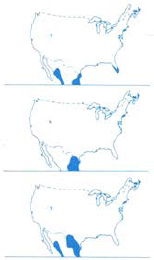
BAHAMA LYSILOMA (Lysiloma latisiliquum) leaves are evergreen, with 2 to 6 pairs of pinnae having numerous oblong leaflets 0.3 to 0.5 of an inch long. Small, greenish-white flowers, in globose heads, produce reddish-brown, pointed pods, 4 to 5 inches long, with dark-brown, oval seeds about 0.5 of an inch long. Branches not spiny. Bahama Lysiloma grows to 60 feet tall, 3 feet in diameter.

LEADTREES (Leucaena spp.), shrubs or small trees, have bipinnate, evergreen leaves with numerous small leaflets; white flowers in globose heads and many-seeded pods; twigs not spiny. Native species include Littleleaf Leadtree (L. retusa) and Great Leadtree (L. pulverulenta). Gregg Leadtree (L. greggii) occurs in Mexico; Leadtree (L. leucocephala) has been introduced in Florida.
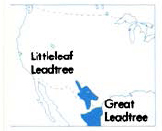

CATCLAW ACACIA (Acacia greggii) leaves are gray-green, with 1 to 3 pairs of pinnae, each with 4 to 6 pairs of oval leaflets to 0.3 of an inch long. Cylindrical spikes of small, creamy-yellow, fragrant flowers are 1 to 2.5 inches long. Fruit a flattened pod, 1 to 6 inches long, 0.8 of an inch wide, often curled and constricted between seeds. Branches bear short, curved spines, 0.3 of an inch long; bark brown and scaly. A shrub or small tree, to 18 feet tall.
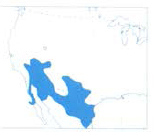
SWEET ACACIA (Acacia farnesiana) has bright-green, deciduous leaves with 2 to 8 pairs of pinnae, each having 10 to 25 pairs of pointed leaflets about 0.2 of an inch long. Small, yellow, fragrant flowers are in globular heads about 0.8 of an inch in diameter. Thickened, lustrous reddish-purple pods, 2 to 3 inches long and 0.5 to 0.8 of an inch in diameter, contain ovoid seeds embedded in pulp. Grows to 30 feet tall and 1.5 feet in diameter, with a round, wide-spreading crown, reddish-brown bark, and straight, stiff spines about 1.5 inches long.

TWISTED ACACIA (Acacia tortuosa) has light-green leaves divided into 3 to 4 pairs of pinnae, with 10 to 15 pairs of small, linear, pointed leaflets. Small, bright-yellow, fragrant flowers in globular heads, 0.5 to 0.8 of an inch in diameter. Fruit a reddish-brown, slightly compressed pod, 3 to 5 inches long and 0.3 of an inch wide, constricted between seeds. Branches bear slender spines, 0.8 of an inch long. Grows to 20 feet tall, 6 inches in diameter; round, widespread crown and dark-brown to black, furrowed bark. Emory Acacia (A. emoryana), a hybrid found in the same region, has flowers in short spikes and has larger pods.

WRIGHT ACACIA (Acacia wrightii) leaves are bright green and somewhat hairy. They are divided into 1 to 3 pairs of pinnae, each with 2 to 5 pairs of leaflets 0.3 to 0.8 of an inch long. Small, light-yellow, fragrant flowers are borne in cylindrical spikes about 1.5 inches long. Fruit is a compressed pod, 2 to 4 inches long and 1 to 1.5 inches wide, with narrow, oval seeds about 0.3 of an inch long. A few stout, curved, chestnut-brown spines, 0.3 of an inch long, occur on the branches. Grows to 30 feet tall and 1 foot in diameter, with a wide crown and scaly, furrowed bark.


MESQUITE (Prosopis glandulosa), including a variety, has deciduous leaves divided into 2, or occasionally 4, pinnae, each with many small leaflets. Greenish-white, fragrant flowers are in slender, cylindrical spikes 1.5 to 4 inches long. Narrow pods, 4 to 9 inches long and 0.3 to 0.5 of on inch in diameter, are constricted between seeds. Spines 0.5 to 2 inches long. Grows 20 to 50 feet tall, 1 to 3 feet in diameter.
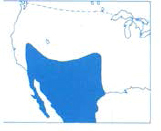
SCREWBEAN MESQUITE (Prosopis pubescens) has hairy, deciduous leaves divided into 2, or occasionally 4, pinnae, each with 10 to 16 small leaflets. Small, greenish-white flowers in cylindrical spikes 2 to 3 inches long. The distinctive spiraled pod is 1 to 2 inches long. This mesquite grows to 20 feet tall, 1 foot in diameter; branches twisted, spiny.
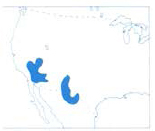
EASTERN REDBUD (Cercis canadensis) leaves are deciduous, broadly ovate to heart-shaped, 3 to 5 inches wide, with a pointed tip and smooth margins. Turn yellow in fall. Flowers pinkish to lavender, 0.5 of an inch long, in loose clusters of 4 to 8; appear before leaves. Pinkish, flattened pods, 2.5 to 3.5 inches long, have several seeds about 0.3 of an inch long. Bark reddish brown, scaly. Usually small, occasionally to 50 feet, with a broad, rounded crown.

CALIFORNIA REDBUD (Cercis occidentalis) leaves are round or notched at apex, 2 to 4 inches broad, with a heart-shaped base and smooth margins. Lavender flowers, 0.5 of an inch long, appear before leaves. Pods are dull red, 1.5 to 3 inches long and 0.5 to 0.8 of an inch wide. Though usually a shrub, California Redbud is sometimes a small tree, to 20 feet tall.

KENTUCKY COFFEETREE (Gymnocladus dioicus) has bipinnately compound leaves, 1 to 3 feet long, with 5 to 9 pinnae, each bearing 6 to 14 pointed, oval leaflets 2 to 2.5 inches long and about 1 inch wide. Terminal racemose clusters of staminate and pistillate flowers are on separate trees; the former 3 to 4 inches long, the latter 10 to 12 inches long. Purplish-brown pods, 4 to 10 inches long and 1 to 2 inches wide, have 6 to 8 round, flattened, reddish-brown seeds, about 0.8 of an inch in diameter, embedded in pulp. Grows 75 to 100 feet tall and 2 to 3 feet in diameter. Furrowed bark is dark gray to brown; branches lack spines.


HONEYLOCUST (Gleditsia triacanthos) has pinnately or bipinnately compound leaves, 7 to 8 inches long. Elliptical to ovate leaflets, about 1 to 2 inches long and 0.3 to 0.5 of an inch wide, with smooth or remotely round-toothed margins; bipinnate leaflets smaller. Flowers greenish white, in racemes. Pods dark reddish brown, twisted, flattened, 7 to 18 inches long and 1 inch wide, with dark-brown, oval seeds, 0.3 of an inch long, in succulent pulp. Branches, and often trunk, armed with simple to 3-branched spines 2 to 3 inches long (thornless form also developed). Bark dark gray-brown, in narrow, flat-topped plates. In moist, fertile soils, Honeylocust grows 75 to 80 feet tall and 2 to 3 feet in diameter. It has a broad, flat-topped crown.

TEXAS HONEYLOCUST (Gleditsia texana) is considered to be a natural hybrid between Honeylocust and Waterlocust. Leaves and leaflets are smaller than Honeylocust’s. Racemes of staminate flowers, 3 to 4 inches long, are orange-yellow; the shorter, many-seeded pods (4 to 5 inches long, 1 inch wide) lack pulp; twigs not spiny. Bark resembles Honeylocust’s. Grows 100 to 120 feet tall and 2.5 feet in diameter. The crown is narrow and spreading.

WATERLOCUST (Gleditsia aquatica) leaves are 5 to 8 inches long and pinnate or bipinnately compound. The ovate-oblong leaflets are 1 inch long and to 0.5 of an inch wide. Flowers, in racemes 3 to 4 inches long, have greenish petals and sepals with soft, orange-brown hairs. Pods are oval, pointed at the apex, chestnut brown, 1 to 2 inches long and 1 inch wide. They lack pulp and contain 1 to 3 flat, nearly round seeds about 0.5 of an inch across. Twigs spiny; bark gray to reddish brown, in small, platelike scales. Waterlocust grows to 60 feet tall and 2.5 feet in diameter, with an irregular, flat-topped crown. It is most common in swampy places.

JERUSALEM-THORN (Parkinsonia aculeata) leaves are short-stemmed, bipinnately compound, with 1 to 3 pairs of wiry, flattened, evergreen pinnae 8 to 20 inches long, and many narrowly oblong, gray-green, deciduous leaflets about 0.1 of an inch long. Flowers golden yellow, in 3- to 6-inch racemes. Pods linear-cylindric, 2 to 6 inches long, constricted between seeds. Both the twigs and the base of the leaves are spiny. Jerusalem-thorn grows 15 to 20 feet tall.


YELLOWWOOD (Cladrastis kentuckea) has pinnately compound leaves, 8 to 12 inches long, with 5 to 11 obovate leaflets 3 to 4 inches long and 1 to 2 inches wide; turn yellow in fall. White flowers are in terminal panicles, 12 to 14 inches long. Pods flat, 2 to 4 inches long, with 4 to 6 seeds. Smooth bark dark gray to brown. Grows to 60 feet tall. 2 feet in diameter.

TEXAS SOPHORA (Sophora affinis) leaves are deciduous, 6 to 9 inches long, and pinnately compound. Each of the 13 to 19 elliptical leaflets is 1 to 1.5 inches long and about 0.5 of an inch wide. Flowers, white tinged with pink, are in racemes 3 to 5 inches long. Black pods are cylindrical, often hairy, 0.5 to 3 inches long and constricted between oval seeds. Grows to 20 feet tall and 10 inches in diameter, with spreading, round-topped crown and dark-brown, scaly bark.

MESCALBEAN (Sophora secundiflora) leaves are evergreen, hairy, pinnately compound, and 4 to 6 inches long. The 7 to 9 elliptical leaflets are 1 to 2.5 inches long and 0.5 to 1.5 inches wide. Fragrant, violet, pealike flowers, about 1 inch long, occur in racemes 2 to 3 inches long. Cylindrical, hairy pods, 1 to 7 inches long and 0.5 of an inch in diameter, are constricted between scarlet seeds that contain poisonous alkaloid (sophrium). A shrub or small tree, to 30 feet tall, with a narrow crown.

BLUE PALOVERDE (Cercidium floridum) has scattered, bipinnately compound leaves, 1 to 1.5 inches long, with 2 pinnae, each with 2 to 3 pairs of dull-green, oblong leaflets 0.3 of an inch long. Yellow flowers, 0.8 of an inch across, are in racemes to 2 inches long. Flat, yellowish-brown pods are 3 to 4 inches long. The twigs are spiny. Smooth bark is bluish gray, becoming scaly and brown. Grows to 25 feet tall.

YELLOW PALOVERDE (Cercidium microphyllum) branches end in sharp spines. Leaves, to 1 inch long, have 2 pinnae, each with 4 to 7 pairs of tiny, elliptical leaflets, which are shed early. Small, yellow flowers are in racemes. Cylindrical pods, 2 to 3 inches long, are constricted between seeds. Bark is yellow-green to gray. A shrub or small tree, to 25 feet tall.

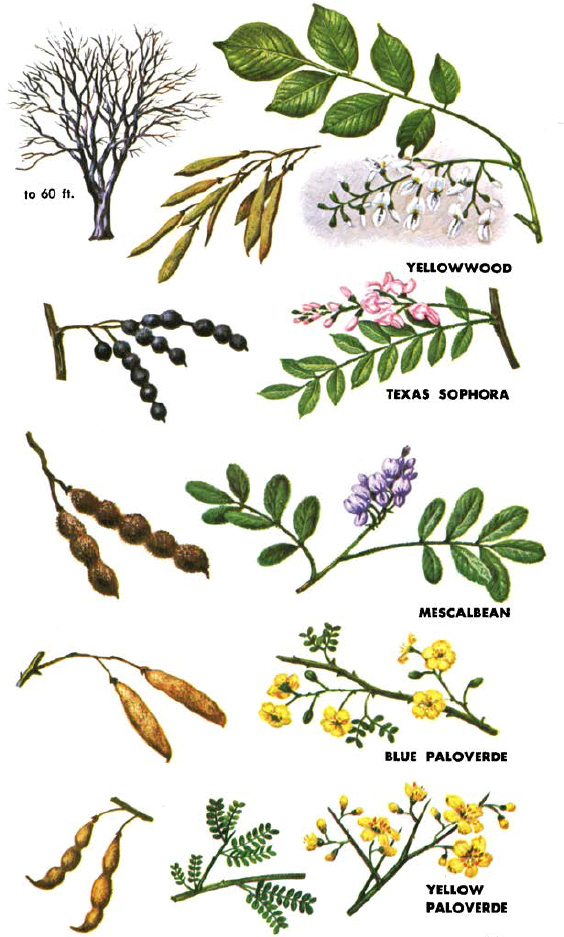
BLACK LOCUST (Robinia pseudoacacia) has pinnately compound leaves, 8 to 14 inches long; 7 to 19 smooth-margined leaflets 1 to 2 inches long, 0.5 to 0.8 of an inch wide. Fragrant, white flowers in drooping racemes. Flat, brown to black pods, 2 to 4 inches long, 0.5 of an inch wide; 4 to 8 kidney-shaped, orange-brown seeds. Spines, 0.5 to 0.8 of an inch, on twigs (on main stem on young trees). Bark nearly black, in “corded” ridges. To 80 feet tall, 2 to 4 feet in diameter.
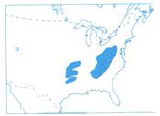
CLAMMY LOCUST (Robinia viscosa) leaves are 7 to 12 inches long, pinnately compound; 13 to 21 oval leaflets, 1.5 to 2 inches long, 0.8 of an inch wide, hairy below. Rose-colored, odorless flowers in drooping racemes. Pods, 2 to 3.5 inches long, contain several reddish-brown, mottled seeds. Twigs sparingly thorny. Pods, leaf stems, and branchlets covered with sticky, clammy hairs. Shrubby to 40 feet tall; bark reddish brown, generally smooth. New-Mexican Locust (R. neomexicana) is a common, generally shrubby species of the Southwest.

SMOKETHORN (Dalea spinosa) has simple, wedge-shaped leaves, 0.8 to 1 inch long, 0.1 to 0.5 of an inch wide, densely hairy, early deciduous. Leaves, twigs, flowers, and pods dotted with glands. Spiny twigs gray with dense hairs when young. Purple flowers, 0.5 of an inch long, in racemes 1 to 1.5 inches long. Ovoid pod contains 1 or 2 seeds. Bark gray-brown, scaly. Smokethorn grows to 20 feet tall.

FLORIDA FISHPOISON-TREE (Piscidia piscipula) has pinnately compound leaves, 4 to 9 inches long, the 5 to 11 leaflets 1.5 to 3 inches long, hairy below and along stems. Flowers white, tinged with red, in panicles; appear in spring before leaves. Winged pods, 3 to 4 inches long and constricted. The bark is olive-gray and scaly. This tree grows to 50 feet tall.

EASTERN CORALBEAN (Erythrina herbacea) has evergreen leaves 6 to 8 inches long, with three shallowly lobed leaflets 2.5 to 3.5 inches long, 1.5 to 2.3 inches wide. Elongated, scarlet flowers, 2 to 2.5 inches long, in racemes 8 to 13 inches long. Pods are 4 to 6 inches long, constricted between scarlet seeds. Branchlets have stout, curved spines. A shrub or small tree, to 25 feet tall. Southwestern Coralbean (E. flabelliformis), ranging from Mexico into southwestern U.S., is occasionally tree size.


RUE FAMILY (Rutaceae)
More than 1,000 species of trees, shrubs, and herbs native to the tropics and warm temperate zones belong to this family. It is best represented in Australia and South Africa, but a number of small trees of this family grow in North America. Several species of Citrus have escaped cultivation and are naturalized in Florida.
HERCULES-CLUB (Zanthoxylum clava-herculis), also called Toothache-tree, has alternate, odd-pinnately compound, tardily deciduous leaves, 5 to 8 inches long. The 7 to 19 leaflets, 1 to 2.5 inches long, are bright green above, paler and somewhat hairy below; margins toothed; stems spiny. Greenish staminate and pistillate flowers on separate trees clustered (in cymes) at ends of branches. Brown, wrinkled capsule, 0.8 of an inch long, splits open to release a black seed on a slender thread. Spines, 0.5 of an inch long, arm stout, gray to brown twigs. A small tree, rarely to 40 feet, with a short trunk; light-gray bark often studded with stout spines.

WEST INDIES SATINWOOD (Zanthoxylum flavum) has alternate, odd-pinnately compound, evergreen leaves, 6 to 9 inches long. The 5 to 11 leathery, ovate to lanceolate to elliptical leaflets are 1.5 to 2 inches long, with smooth or finely toothed margins and dotted with translucent glands. Both flowers and fruits are similar to those of Hercules-club, but twigs are not spiny. Smooth, light-gray bark becomes fissured with age. Grows to 20 feet tall.

LIME PRICKLY-ASH (Zanthoxylum fagara) leaves are evergreen, alternate, odd-pinnately compound, 3 to 4 inches long, with 7 to 9 glandular-dotted leaflets finely toothed above middle. Leaf stems are winged; brownish twigs spiny. Yellow-green staminate and pistillate flowers in axillary clusters (cymes) on separate trees. Warty, brown capsule contains one black seed. A shrub or small tree, to 30 feet tall, with thin, gray, “warty” bark.

COMMON PRICKLY-ASH (Zanthoxylum americanum) foliage resembles Hercules-club, but margins of leaflets (5-11) are smooth or have only small, rounded teeth. Small, greenish flowers are in sessile, axillary clusters. Bark gray to bluish. It is usually a spiny shrub but occasionally is a small tree, to 25 feet tall.

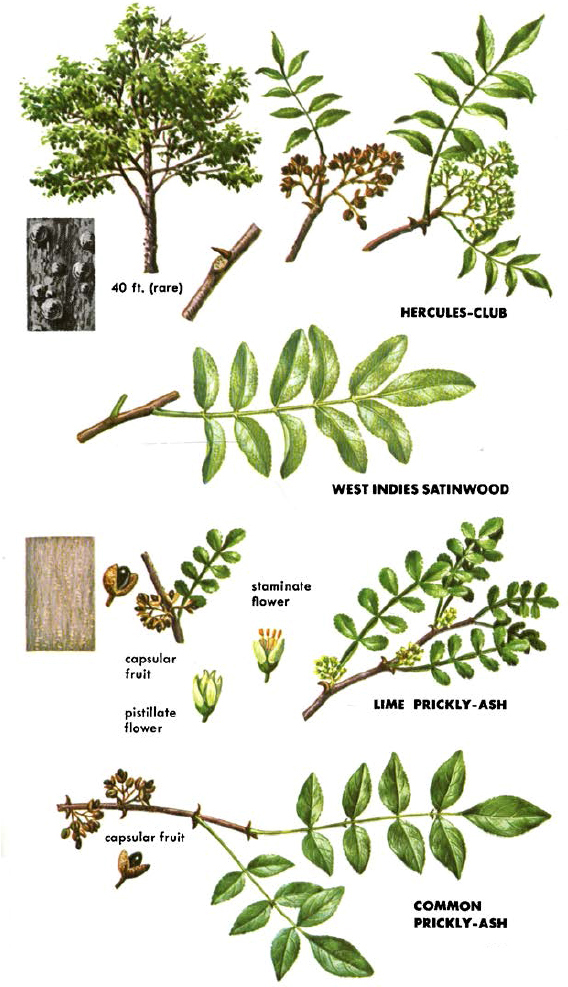
COMMON HOPTREE (Ptelea trifoliata) has alternate, usually 3-foliate, deciduous leaves, 4 to 6 inches long; leaflets, 2 to 4 inches long, have smooth to finely toothed margins. Polygamous, greenish-white flowers in terminal clusters (cymes). Buff-colored, wafer-like fruit (samara), about 1 inch in diameter, has a broad, veined wing. Twigs slender, giving off rank odor when broken. Bark thin, gray, warty. Crown broad, rounded; to 25 feet tall, 1 foot in diameter. Pale Hoptree (P. pallida) and Narrowleaf Hoptree (P. angustifolia), most commonly shrubs, grow in southwestern United States and also in Mexico.
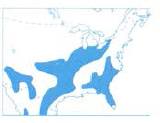
TORCHWOOD (Amyris elemifera) has opposite, evergreen leaves, with 3 broadly lance-shaped leaflets, each 1 to 2.5 inches long; margins smooth or with small rounded teeth. Flowers white, in terminal clusters (panicles). Fruit black, cherry-like, palatable, about 0.5 of an inch in diameter. Bark thin, gray-brown, becoming furrowed. To 20 feet tall, 1 foot in diameter. Balsam Torchwood (A. balsamifera) ranges from Florida southward.
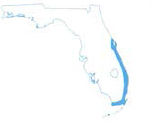
BURSERA FAMILY (Burseraceae)
GUMBO-LIMBO (Bursera simaruba) has alternate, odd-pinnately compound leaves, 6 to 8 inches long, clustered at ends of branches. The 3 to 9 leathery leaflets are 2 to 3 inches long. Small, greenish-white flowers in racemes 2 to 5 inches long. Red, leathery, 3-angled fruits, about 0.3 of an inch long, split into 3 parts, releasing single seed. Bark thin, smooth, reddish brown; light wood sometimes used for fishing floats. To 60 feet tall, 3 feet in diameter. Elephanttree (B. microphylla) and the smaller Fragrant Bursera (B. fagaroides) are shrubs or small trees of southwestern U.S. Flowers and fruits are similar to Gumbo-limbo’s; leaves have winged petioles and 5 to 30 leaflets about 0.8 to 1.5 inches long.
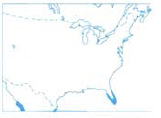
CALTROP FAMILY (Zygophyllaceae)
ROUGHBARK LIGNUMVITAE (Guaiacum sanctum) has opposite, even-pinnately compound, evergreen leaves, with 3 to 4 pairs of opposite, leathery, smooth-margined leaflets about 1 inch long. Blue flowers, about 0.8 of an inch across, in 2- to 4-flowered, terminal clusters. Orange, obovoid, fleshy capsule, about 0.8 of an inch long, contains scarlet-coated black seeds. Bark chalky; wood heavy. To 30 feet tall.


AILANTHUS (QUASSIA) FAMILY
(Simaroubaceae)
PARADISE-TREE (Simarouba glauca) leaves are evergreen, pinnately compound, alternate, and to 10 inches long. Their 10 to 14 leathery, oblong to obovate leaflets are 2 to 3 inches long and either alternate or opposite; dark green above, lighter below. Yellow staminate and pistillate flowers, on separate trees are in axillary or terminal clusters (panicles). Fruit, about 1 inch long, is red, becoming purple as it ripens. A small tree, to 50 feet tall and 2 feet in diameter, with brown, scaly bark.

BITTERBUSH (Picramnia pentandra) leaves are evergreen, alternate, odd-pinnately compound and 8 to 12 inches long, with 5 to 9 leathery, pointed leaflets 1 to 3 inches long. Greenish staminate and pistillate flowers on separate trees, in slender racemes, 6 to 8 inches long. Oval fruit is 1- to 2-seeded and about 0.5 of an inch long, lustrous black when ripe. Slender twigs are hairy. A shrub or small tree, Bitterbush grows to 20 feet tall and 6 inches in diameter. It has smooth, yellowish-brown bark.

MEXICAN ALVARADOA (Alvaradoa amorphoides) has alternate, pinnately compound, evergreen leaves, 4 to 12 inches long. The 21 to 41 leaflets, 0.5 to 0.8 of an inch long, taper from a broad, round apex. Staminate and pistillate flowers, on separate trees, are in slender racemes 3 to 8 inches long. Reddish fruit is lance-shaped and 2-winged with fringed margins, about 0.8 of an inch long. A shrub or small tree of dry soils, to 45 feet tall and 8 inches in diameter, with gray or reddish-tinged bark.
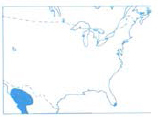
AN INTRODUCED MEMBER OF AILANTHUS FAMILY
AILANTHUS (Ailanthus altissima), also called Tree-of-Heaven, has alternate, odd-pinnately compound, deciduous leaves, 1 to 3 feet long. The 11 to 41 ovate to ovate-lanceolate leaflets are 3 to 5 inches long and 1 to 2 inches wide. They are toothed at the base and have a disagreeable odor when crushed. Staminate and pistillate flowers are on different trees; they are small, greenish, and in dense, terminal panicles. Staminate flowers also have an unpleasant odor. The fruit is an oblong, twisted samara, about 15 inches long, with a seed in the center of the wing. They are in large, dense clusters that hang on the tree through the winter. Bark is thin, dark gray, and somewhat roughened. A rapidly growing tree with stout, hairy twigs and a flat-topped crown of stout branches, Ailanthus thrives even in poor soils and may grow 100 feet tall and 3 feet in diameter. A successful volunteer, it produces many suckers. Native to eastern Asia, it is found even in Brooklyn. Grown widely as an ornamental; often considered a weed tree.

MAHOGANY FAMILY (Meliaceae)
WEST INDIES MAHOGANY (Swietenia mahagoni) leaves are evergreen, alternate, even-pinnately compound, 4 to 7 inches long, the 6 to 8 leathery, ovate to lanceolate, opposite leaflets 3 to 4 inches long. Flowers cup-shaped, 0.1 of an inch long, the 5 petals greenish or white; in long, axillary panicles. Reddish-brown capsular fruit, 3 to 4 inches long, splits from base along 5 valves, releasing squarish, winged seeds about 0.8 of an inch long. Bark dark brown, scaly: To 60 feet tall, 2 feet in diameter; rare in U.S.

AN INTRODUCED MEMBER OF MAHOGANY FAMILY
CHINABERRY (Melia azedarach) has alternate, bipinnately compound, deciduous leaves, 1 to 2 feet long. The numerous bright-green, pointed leaflets 1 to 3 inches long, with toothed (or slightly lobed) margins. Purplish, showy, fragrant flowers, about 0.8 of an inch in diameter; in loose panicles, 4 to 8 inches long. Fleshy fruits, 0.5 to 0.8 of an inch in diameter, yellow when mature. Rapid-growing, short-lived tree native of Asia, grown as an ornamental in southern U.S.
SPURGE FAMILY (Euphorbiaceae)
The more than 7,000 species of herbs, shrubs, and trees in this family include the Para or Brazilian Rubber Tree (Hevea brasiliensis), Tapioca (Manihot esculenta), and other commercially valuable tropical plants, plus poinsettia, crotons, snow-on-the-mountain, and other ornamentals. Castor-bean Plant (Ricinus communis) plus Brazil Sapium (Sapium glandulosum) and the Chinese Tallowtree (S. sebiferum), both related to Mexican Jumping-bean (S. biloculare), have escaped cultivation and now grow in warm parts of North America. Many members of the family have a milky juice, poisonous in some.
GUIANA-PLUM (Drypetes lateriflora) leaves are evergreen, alternate, smooth-margined, broadly elliptical, 2 to 4 inches long. Small, greenish staminate and pistillate flowers in leaf axils on separate trees, the staminate clustered. Fruit a scarlet, nearly globose drupe about 0.3 of an inch in diameter. Bark light brown, smooth; usually scaly. A shrub or small tree, to 25 feet tall, 6 inches in diameter. Milkbark (D. diversifolia), found only in southern Florida, has white fruit.

OYSTERWOOD (Gymnanthes lucida) has leathery, alternate, evergreen leaves, 2 to 3 inches long; margins usually smooth. Staminate (clustered) and pistillate (usually solitary) flowers on adjoining axillary stalks. Fruit a dark, 3-lobed capsule, 0.3 of an inch in diameter. To 35 feet tall. Bark thin, scaly.
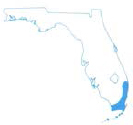

MANCHINEEL (Hippomane mancinella) has alternate, broadly ovate leaves, 3 to 4 inches long, 1 to 2 inches wide; tips pointed, margins finely round-toothed. Flowers in terminal stalks 4 to 6 inches long; yellow-green staminate above, pistillate below. Fruits drupaceous, yellow-green with red cheeks, 1.5 inches in diameter, with milky flesh. Bark white to dark brown, smooth; scaly on large trunks. A shrub or small tree, to 20 feet tall, 6 inches in diameter. Sap highly poisonous.

CASHEW (SUMAC) FAMILY (Anacardiaceae)
This family, represented in temperate and tropical regions, comprises about 600 species of trees, shrubs, and vines, with resinous, acrid, or caustic juice. In addition to the species listed here, the Mango (Mangifera indica) is grown in Florida and throughout the tropics and subtropics for its fruit. Peppertree (Schinus molle), from South America, is grown as an ornamental in California and in southern Florida, where it is now naturalized and grows wild. Cashew (Anacardium occidentale) and Pistachio (Pistachia vera) are grown mainly in the tropics for nuts.
AMERICAN SMOKETREE (Cotinus obovatus) has alternate, simple, oval to obovate, deciduous leaves, 4 to 6 inches long, 2 to 3 inches wide; margins smooth, curled under; hair on veins below. Leaves turn orange or red. Dioecious; sparsely flowered terminal clusters, 5 to 6 inches long. Fruit a dry, oblong, compressed, brown drupe, 0.3 of an inch long. Shrubby, to 35 feet tall.

FLORIDA POISONTREE (Metopium toxiferum) leaves are evergreen, alternate, odd-pinnately compound, 6 to 10 inches long, the 5 (occ. 3) to 7 leaflets 3 to 4 inches long, 2 to 3 inches wide, with slightly curled margins. Dioecious; the yellow-green flowers in loose clusters 6 to 12 inches long in leaf axils near tips of branches. Orange fruits (drupes) 0.8 of an inch long, resinous. Bark thin, reddish brown, mottled with dark, gummy secretions; scaly on older trees. A shrub or small tree, to 35 feet tall. Poisonous to touch.

TEXAS PISTACHE (Pistacia texana) leaves are evergreen, alternate, pinnately compound, with slightly winged stems. The 9 to 19 leaflets, 0.8 of an inch long, widest above middle. Dioecious; small flowers without sepals or petals, in panicles to 2.5 inches long. Fruit a dark reddish-brown drupe, 0.2 of an inch long. A shrub or small tree, to 30 feet tall.
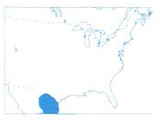

STAGHORN SUMAC (Rhus typhina) leaves are deciduous, alternate, odd-pinnately compound, and 12 to 24 inches long, with stout, hairy stems. The 11 to 31 lance-shaped leaflets are 2 to 5 inches long, with toothed margins; dull green above, paler and hairy on midrib below; scarlet in fall. Greenish staminate and pistillate flowers in dense panicles at ends of branches on separate trees. Fruits dry, red-hairy drupes, 0.1 of an inch in diameter. Stout, densely hairy twigs exude milky fluid when crushed. Bark of young trees thin, dark brown; on older trees, scaly. Shrub or small tree, to 35 feet tall. Smooth Sumac (R. glabra), similar but smaller, has smooth twigs. Lemonade Sumac (R. integrifolia) and Kearney Sumac (R. kearneyi) are among western species occasionally tree size. Grows in dry places.

SHINING SUMAC (Rhus copallina) leaves are similar to Staghorn Sumac’s but have winged stems and fewer leaflets (9 to 21), usually not toothed. Flower clusters less dense, fruits smaller. Bark thin, reddish brown.

POISON-SUMAC (Toxicodendron vernix) leaves are 7 to 15 inches long, similar to those of Rhus but smaller and with fewer leaflets. Leaflets 3 to 4 inches long, with smooth margins. Clusters of greenish-yellow flowers produce ivory-white drupes about 0.3 of an inch in diameter. Thin, gray-brown bark smooth except for lenticels. Usually a shrub, rarely to 30 feet. Contains poisonous oil, like Poison Ivy of same genus. Grows in wet places.
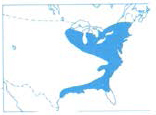
CYRILLA FAMILY (Cyrillaceae)
SWAMP CYRILLA (Cyrilla racemiflora) leaves are simple, alternate, 2 to 3 inches long and 0.5 to 1 inch wide; tardily deciduous. Fragrant, white to pinkish flowers in racemes 4 to 6 inches long, near end of twigs. Dry, conical fruit about 0.1 of an inch long. Bark is lustrous reddish brown. To 25 feet tall. A small tree-size variety, Littleleaf Cyrilla (C. racemiflora parvifolia), is found in Georgia and Florida.
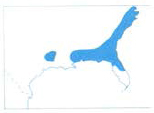
BUCKWHEAT-TREE (Cliftonia monophylla) has simple, alternate, smooth-margined, evergreen leaves, 1 to 2 inches long and to 1 inch wide. Flowers white to pink, in slender, erect racemes. Fruit 4-winged, about 0.3 of an inch long. Bark reddish brown. A shrub or small tree, Buckwheat-tree grows to 35 feet tall and may form thickets in moist soils.


HOLLY FAMILY (Aquifoliaceae)
Hollies (Ilex) are the most familiar of three genera of trees and shrubs in this family, with nearly 300 species in temperate and tropical areas of both hemispheres. In addition to the species described here, six others that are most commonly shrubs are native to eastern United States. Those with leathery, spiny-toothed, evergreen leaves, and bright-red fruits are used in Christmas decorations. Others are deciduous, with smooth-margined leaves and fruits of a different color. In all hollies the leaves are alternate.
AMERICAN HOLLY (Ilex opaca) has leathery, evergreen leaves, 2 to 4 inches long and 1 to 2 inches wide, with a sharp-pointed tip and spiny-toothed (occasionally smooth) margins. Greenish-white staminate and pistillate flowers borne on separate trees. Fleshy, berry-like, bright-red fruits, 0.3 of an inch in diameter, contain several ribbed nutlets. Bark thin, gray, often warty. Grows to 50 feet tall, with short branches forming a narrow, pyramidal crown.

TAWNYBERRY HOLLY (Ilex krugiana) leaves are evergreen, 2.5 to 4 inches long and 1 to 1.5 inches wide. They have a long-pointed apex and smooth margins. Flowers are similar to American Holly’s, and fruits, about 0.1 of an inch long, are purple-brown. Grows as a shrub or a small tree, to 30 feet tall and 6 inches in diameter. On twigs or trunks of young trees, bark is smooth and whitish; on mature trees, scaly and brown.

DAHOON (Ilex cassine) leaves are evergreen, oblanceolate to oblong-ovate, 1.5 to 3 inches long and 0.5 to 1 inch wide, with margins smooth or slightly toothed above the middle. Flowers, similar to American Holly’s, produce bright-red, occasionally yellowish fruits, 0.3 of an inch in diameter. The gray bark is marked with numerous lenticels. Dahoon grows to 30 feet tall and 1.5 feet in diameter. It is often common in moist soils.

YAUPON (Ilex vomitoria) resembles Dahoon, but has smaller, elliptical, toothed leaves. The scarlet fruits are produced in greater abundance. Bark scaly and brown. Yaupon grows as a shrub or small tree, to 20 feet tall and 6 inches in diameter, often forming dense thickets. The leaves of Yaupan have been used in preparing a purgative.


POSSUMHAW (Ilex decidua) has ovate-lanceolate, deciduous leaves, 2 to 3 inches long and 0.5 to 1 inch wide, with finely toothed margins. Flowers are similar to American Holly’s, and the fruits, 0.3 of an inch in diameter, are reddish orange. Thin, smooth bark is greenish gray to brown. Usually a shrub but occasionally grows to 25 feet tall; common in moist soils.

MOUNTAIN WINTERBERRY (Ilex montana) resembles Possumhaw, but the leaves are 2 to 5 inches long and 0.5 to 2.5 inches wide, with larger, glandular, marginal teeth. Red fruits 0.5 of an inch in diameter.

AN INTRODUCED HOLLY
ENGLISH HOLLY (Ilex aquifolium), of Europe and Asia, is widely planted as an ornamental. Resembles American Molly, but English Holly has smaller leaves and a greater abundance of fruit.
BITTERSWEET FAMILY (Celastraceae)
EASTERN WAHOO (Euonymus atropurpureus) has opposite, ovate to elliptical, deciduous leaves, 2 to 5 inches long and 1 to 2 inches wide, with finely toothed margins. Perfect flowers are 0.5 of an inch wide, with 4 dark-purple petals, in 7- to 15-flowered, axillary clusters. Fruit, 0.5 of an inch in diameter, a deeply 4-lobed purplish-red capsule with red seeds. Bark thin, gray, scaly. To 25 feet. The similar Western Wahoo (E. occidentalis) is most commonly a shrub.
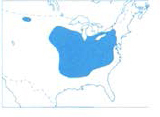
FALSEBOX (Gyminda latifolia) leaves are leathery, evergreen, 1 to 2 inches long and 0.8 to 1 inch wide, opposite, obovate, with smooth or finely toothed margins. Staminate and pistillate flowers, in short-stalked, axillary clusters (cymes) on separate trees, have 4 white petals. Black to dark-blue, oval, drupaceous fruits are about 0.3 of an inch long. Bark thin, scaly, light brown, often mottled with red. A shrub or small tree, to 25 feet tall.
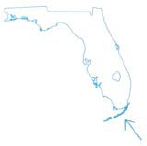
CANOTIA (Canotia holacantha) is a leafless shrub or small tree, to 18 feet tall and 1 foot in diameter, with rough, gray-brown bark and many upright, yellowish-green branches and twigs ending in spiny tips. Greenish-white flowers, 0.3 of an inch across, are in clusters of 3 to 7 along the twigs. The fruit is a woody, ovoid, pointed capsule to 1 inch long. Typical of dry slopes and mesas.
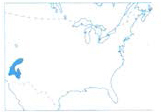

MAPLE FAMILY (Aceraceae)
Maples (Acer) are among the most distinctive trees and shrubs in North America. Their winged seeds are in pairs (rarely in 3’s) and their deciduous leaves are opposite on the branches. In most species the leaves are simple and palmately lobed. An exception is the Boxelder (Acer negundo), which has odd-pinnately compound foliage. Boxelder also differs from other native maples in having staminate and pistillate flowers on separate trees.
Maples, with nearly 150 species, are most abundant in eastern Asia. About a dozen species are native to the United States and Canada, but a number of foreign species have been introduced as ornamentals. The maple family has one other genus (Dipteronia), native to China.
SUGAR MAPLE (Acer saccharum) leaves are 3 to 5 inches in diameter and usually 5-lobed, their margins with several large, pointed teeth and the sides of the center lobe roughly parallel. Clusters of yellow, long-stemmed polygamous flowers develop with leaves. Inch-long, U-shaped pair of winged seeds ripen in fall. On young trees the bark is smooth and gray-brown, becoming scaly and furrowed with maturity. Sugar Maple grows 75 to 100 feet tall and 2 to 4 feet in diameter. In crowded woods, it has a long, branchless trunk; in the open a shorter trunk and a large, rounded crown. Its hard wood is used for furniture, in cabinet work, for interior trim, and flooring. The sap is the source of maple sugar and syrup. Sugar Maples are popular for shade and ornamental plantings because of their colorful red-and-yellow fall foliage.

BLACK MAPLE (Acer nigrum) is similar to the Sugar Maple, but the leaves are usually 3-lobed. In addition, the sides of the leaves tend to bend downward, and the underside, especially along the yellow veins, is somewhat hairy. Like the Sugar Maple, it is tapped in early spring for its sugary sap, and its hard wood is commercially valued.

FLORIDA MAPLE (Acer barbatum) resembles Sugar Maple but is smaller, growing to 60 feet tall and 3 feet in diameter. Its blue-green, 3- to 5-lobed leaves are 1.5 to 3 inches in diameter and usually hairy below. The lobes have wavy margins and rounded rather than pointed tips. In Florida Maple, the base of the leaf stem is noticeably enlarged.


RED MAPLE (Acer rubrum) leaves are 2 to 6 inches across, with 3, or occasionally 5, roughly triangular, coarsely toothed lobes; turn scarlet in autumn. Leaf stems usually reddish. Red to yellow polygamous flowers, in short-stemmed clusters, appear before the leaves. The paired seeds have slightly divergent wings, 0.8 of an inch long; they ripen in late spring. The twigs are reddish, with blunt reddish buds. The smooth, light-gray bark of young trees develops narrow, scaly plates with age. Red Maple reaches 75 to 80 feet in height and 1 to 2 feet in diameter. This tree grows rapidly, especially in moist to swampy soils. It is commonly planted as an ornamental.
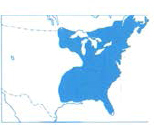
SILVER MAPLE (Acer saccharinum) leaves are 6 to 7 inches across and deeply 5-lobed, with large marginal teeth; silvery below. Clusters of short-stemmed, greenish-yellow polygamous flowers appear before the leaves in early spring and produce paired seeds with widely spread wings, 1.5 to 2 inches long. The seeds ripen in spring. The bark of young trees is smooth and silver-gray; bark of old trees is characterized by long, narrow scales loose at their ends, giving the trunk a “shaggy” appearance. Silver Maple, typical of moist soils, grows rapidly. It reaches a height of 60 to 80 feet and a diameter of 2 to 4 feet, with a widespread crown of brittle branches. Although this maple is planted as an ornamental, its leaves do not become highly colored in fall.
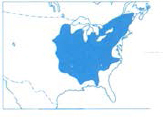
BIGTOOTH MAPLE (Acer grandidentatum) leaves are 2 to 5 inches in diameter and 3-lobed, with blunt teeth on their margins. Leaves turn red or yellow in fall. The flowers, appearing with the leaves, resemble Sugar Maple’s. The U-shaped, paired, winged seeds of Bigtooth Maple are about an inch long. The thin, gray to brown bark may be smooth or scaly. This tree grows to 50 feet tall and 1 foot in diameter, with a spreading, rounded crown. It is usually found in moist soils along canyon streams.

CHALK MAPLE (Acer leucoderme) leaves are 2 to 3.5 inches in diameter with 3 (occasionally 5) blunt lobes, their margins wavy or with widely spaced, blunt teeth. The leaves are hairy below and often turn red in fall. The flowers resemble those of Sugar Maple, but the paired seeds have widely spread wings, 0.5 to 1 inch long. Chalk Maple’s bark is smooth and chalky white. This maple grows to 25 feet tall.
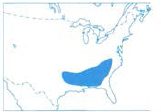

STRIPED MAPLE (Acer pensylvanicum) leaves are 5 to 6 inches long and 4 to 5 inches wide, with a rounded to heart-shaped base, and 3-lobed with doubly toothed margins. Turn yellow in fall. Bright-yellow flowers are borne in slender, drooping racemes 4 to 6 inches long, appearing when leaves are nearly grown; staminate and pistillate flowers are separate but on the same tree. Paired seeds have widely spread wings, about 0.8 to 1 inch long. Twigs and buds smooth. Bark smooth and green, with longitudinal, whitish stripes; later darker and warty. A shrub or small tree, to 40 or more feet tall; common in cool, moist places.

MOUNTAIN MAPLE (Acer spicatum) leaves have 3 (occasionally 5) lobes with coarsely toothed margins. The yellow flowers are in erect racemes, with staminate above and pistillate below; they appear after the leaves and produce paired seeds with somewhat divergent wings, about 0.5 of an inch long; they are red in midsummer. Twigs and buds covered with fine “hairs.” The thin bark is reddish brown. A shrub or small tree, to 30 feet tall. Mountain Maple is common in cool, moist places.

BIGLEAF MAPLE (Acer macrophyllum) leaves may be 12 inches in diameter, largest of any maple. The 5 deeply cut lobes have smooth margins, except for a few large, blunt teeth. In autumn, leaves turn yellow-brown. Pendant racemes of yellow, somewhat fragrant polygamous flowers appear with leaves. Paired seeds have slightly divergent wings, 1.5 to 2 inches long, with a densely brown-haired seed cavity; mature in fall. On young trees, bark is smooth, greenish brown; on old trees, black and deeply ridged. Grows to 100 feet tall, 4 feet in diameter. In open situations, trunk usually short, crown broad.
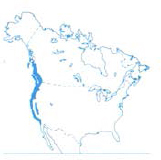
VINE MAPLE (Acer circinatum) leaves are 2 to 6 inches in diameter, with 7 to 9 pointed lobes having toothed margins. The leaves are usually tinged with red when they unfold; turn scarlet in fall. Loose clusters of purple-red polygamous flowers appear when leaves are about half grown. The paired, red seeds have widely divergent wings, 0.8 of an inch long. Ripen in fall. Usually a tall shrub with many supple stems; occasionally a small tree—to 40 feet tall and 1 foot in diameter. Bark smooth, greenish to reddish brown. Commonly forms dense thickets on logged-off land in Pacific Northwest. A favored browse food of deer.


BOXELDER (Acer negundo) with its several varieties, has pinnately compound leaves, 6 to 15 inches long, with 3 to 7 coarsely toothed or shallowly lobed leaflets. Greenish-yellow staminate and pistillate flowers are on separate trees, the staminate in drooping clusters and the pistillate in drooping racemes. V-shaped, winged seeds are 1.5 to 2 inches long, the clusters hanging on the branches through winter. On young trees, bark is gray-brown and slightly ridged; on old trees, heavily furrowed. Rapid-growing but short-lived, Boxelder reaches a height of 50 to 75 feet and a diameter of 2 to 4 feet. It prefers moist soils along streams, ponds, and lakes but is hardy on poor sites.

ROCKY MOUNTAIN MAPLE (Acer glabrum) resembles Vine Maple but has smaller leaves, 3 to 5 inches in diameter, with 3 to 5 lobes. The wings of its seeds are spread only slightly. Douglas Maple (A. glabrum var. douglasii) often grows with the more common Vine Maple in the Pacific Northwest.

SOME INTRODUCED MAPLES
NORWAY MAPLE (Acer platanoides) leaves resemble Sugar Maple’s, but the stems exude a milky fluid when squeezed. Also, the clustered, long-stemmed, greenish-white flowers appear after the leaves, and the winged seeds, 1.5 to 2 inches long, are widely spread.
PLANETREE (SYCAMORE) MAPLE (Acer pseudoplatanus) grows to 90 feet tall, with a wide-spreading crown and scaly bark. Leaves are 3 to 7 inches in diameter, 5-lobed, and coarsely toothed. Greenish-yellow flowers, in pendant panicles 3 to 6 inches long, appear after leaves. Paired seeds have wings 1.3 to 2 inches long, spread widely to form a right angle.
FULLMOON MAPLE (Acer japonicum) has 7- to 11-lobed leaves, 2 to 5 inches in diameter, with sharply toothed margins and drooping clusters of purple flowers. Winged seeds spread in wide “V”, 1.8 to 2 inches long. To 25 feet tall.
ENGLISH FIELD MAPLE (Acer campestre) is a small tree, to 30 feet tall, with a rounded crown. Its small leaves, 1 to 4 inches in diameter, have 3 to 5 blunt lobes with smooth margins or rounded marginal teeth. The greenish-white flowers are in clusters, and the winged seeds, 1 to 1.3 inches long, are spread wide, sometimes forming almost a straight line.
JAPANESE MAPLE (Acer palmatum) has deeply cleft leaves, 2 to 4 inches in diameter, with 5 to 9 narrow, pointed, toothed lobes. It bears erect clusters of purple flowers, producing widely spread winged seeds about 0.8 of an inch long. A shrub or small tree, to 25 feet tall.
AMUR MAPLE (Acer ginnala) has narrow, 3-lobed, toothed leaves. They are 1.5 to 3.5 inches long and 1.3 to 2.5 inches wide. Clusters of yellow flowers produce V-shaped, winged seeds about 1 inch long. A shrub or small tree, to 20 feet tall.

HORSECHESTNUT (BUCKEYE) FAMILY
(Hippocastanaceae)
This family has but two genera, most important being the horsechestnuts, or buckeyes, including about 30 species of trees and shrubs of North America, southeastern Europe, and Asia. Approximately one-third are native to the United States. All have opposite, palmately compound, deciduous leaves, the margins of the leaflets coarsely toothed. Large, showy, erect panicles of tubular or bell-shaped flowers develop after the leaves in the spring. Large, leathery capsules, 1 to 3 inches in diameter, are formed by fall. They split open when ripe and release the round, inedible seeds, 1 to 2 inches in diameter. Except for a large, lighter spot (hilum), they are a polished, dark chestnut brown.
The other genus in this family (Billia) includes two species of evergreen trees native to the area from Colombia north into Mexico.
YELLOW BUCKEYE (Aesculus octandra) leaves have 5 to 7 short-stemmed, obovate, pointed leaflets, each 4 to 6 inches long and 1.5 to 2.5 inches wide. The yellow flowers, hairy below and with stamens shorter than the petals, are borne in erect panicles, 5 to 7 inches long. The capsules, about 2 inches in diameter, are smooth on the surface and usually enclose two seeds, each about 1 to 1.5 inches in diameter. Brown bark is fissured and scaly. Grows 50 to 90 feet tall and 2 to 3 feet in diameter; crown oblong, rounded.
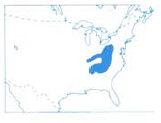
OHIO BUCKEYE (Aesculus glabra) resembles Yellow Buckeye but has narrower leaflets, stamens are longer than the petals, and surface of capsules is spiny. Also, leaves and twigs have an unpleasant odor when bruised. Texas Buckeye (A. arguta), once considered a variety, is similar to Ohio Buckeye.
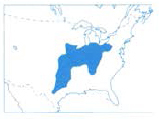
PAINTED BUCKEYE (Aesculus sylvatica) leaves have 5 short-stemmed, oblong-obovate, pointed leaflets, each 4.5 to 6 inches long and 1.5 to 2.5 inches wide, with an orange midrib. Flowers are yellow, occasionally tinged with red, and hairless. Smooth-surfaced capsules usually contain only one seed. Painted Buckeye grows to 30 feet tall, 10 inches in diameter. It has brown, scaly bark.

RED BUCKEYE (Aesculus pavia) leaves have 5 short-stemmed, oblong-obovate leaflets, 4 to 5 inches long and 1.5 to 2 inches wide. Dark-red flowers produce smooth-surfaced capsules containing 1 to 2 seeds. A shrub or small tree. Red Buckeye grows to 25 feet tall; bark smooth, pale brown.
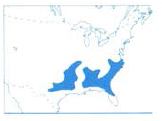

CALIFORNIA BUCKEYE (Aesculus colifornica) leaves have 4 to 7 (usually 5) distinctly stemmed, oblong-lanceolate leaflets. Each is 4 to 6 inches long and 1.5 to 2 inches wide. Trees growing in drier foothill regions usually lose their leaves early. White to pale-rose flowers are produced in panicles 5 to 10 inches long, and the pear-shaped, usually one-seeded capsules are 1.5 to 2 inches long and smooth-surfaced. California Buckeye may be a shrub or a small tree, to 40 feet tall and 8 inches in diameter. Its bark is smooth and light gray to brown.
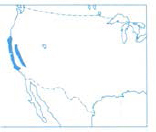
AN INTRODUCED MEMBER OF BUCKEYE FAMILY
HORSECHESTNUT (Aesculus hippocastanum) leaves have 5 to 7 leaflets, each 4 to 10 inches long and 2 to 3.5 inches wide, distinctly widest near abruptly pointed apex. Creamy-white flowers are marked with red or yellow and are borne in erect panicles 8 to 12 inches long. Spiny capsules are 2.5 inches in diameter and contain 1 to 2 large seeds. Terminal bud large and sticky. Dark-brown bark is smooth or broken into irregular plates. A medium-sized to large tree, 25 to 60 feet tall, with rounded crown of wide-spreading branches. Horsechestnut is native to Asia and southeastern Europe; it is planted as a shade and street tree throughout central North America.
PAPAYA FAMILY (Caricaceae)
This is a small family of tropical and subtropical shrubs and trees. Best-known member is the Papaya, native from southern Florida southward into the tropics. Horticultural varieties are now widely planted in subtropical and tropical regions. The fruit is eaten raw or is processed to make juice. Papain, from the milky sap of stems and young fruit, is used as a meat tenderizer.
PAPAYA (Carica papaya) leaves are evergreen, 12 to 24 inches in diameter, palmately lobed, with pointed tips. The base is deeply heart-shaped, and the stout stems are 1 to 3 feet long, hollow, and enlarged at base. Staminate and pistillate flowers are borne in different clusters on separate trees or, less commonly, on the same tree. Staminate flowers are fragrant, with 5 spreading lobes at apex of narrow tube, clustered on long, many-flowered stalks; pistillate flowers tubular with separate petals, 1 to 3 on short stalks. Fruits melon-like, yellowish green to orange, about 4 inches long and 3 inches in diameter (much larger in horticultural forms), with a thick skin and sweet, whitish to orange flesh enclosing many dark seeds. Bruised twigs exude milky sap. Bark smooth, greenish gray. Papaya grows to 20 feet tall and 6 inches in diameter.

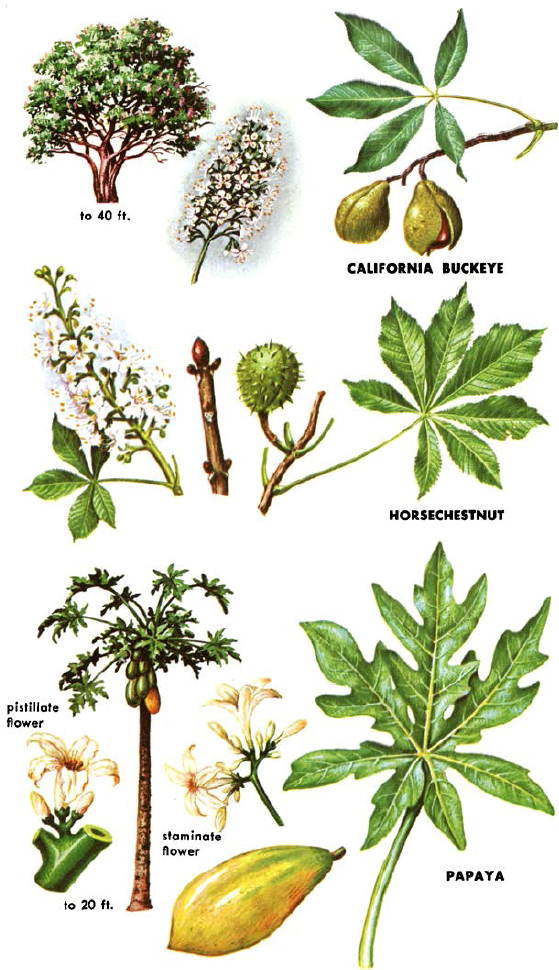
BUCKTHORN FAMILY (Rhamnaceae)
Includes some 600 species of shrubs and small trees, largely tropical and subtropical. About 100 species in United States. In addition to the native species described here, Common Jujube (Ziziphus jujube), from Asia, Africa, and Australia, is grown as an ornamental in California and is naturalized in parts of the South.
CASCARA BUCKTHORN (Rhamnus purshiana) has usually alternate, broadly elliptical, deciduous leaves, 2 to 6 inches long and 1 to 2 inches wide; apex rounded or bluntly pointed, margins finely toothed and slightly curled under. Small clusters of tiny yellowish-green flowers occur in leaf axils. Black, globose, fleshy fruits, about 0.3 of an inch in diameter, contain several seeds. The bark is smooth and dark gray, often with cream-colored stripes; contains a drug used in laxatives. A small tree, to 40 feet tall. Birchleaf Buckthorn (R. betulaefolia) and the evergreen California Buckthorn (R. californica), usually shrubs, grow in the Southwest.

CAROLINA BUCKTHORN (Rhamnus caroliniana) resembles Cascara Buckthorn but has tapered leaves and greenish-white flowers. The fruit has a drier flesh. The ash-gray bark is smooth to slightly furrowed, sometimes with dark markings. Carolina Buckthorn is a shrub or a small tree, growing to 30 feet tall.

LEADWOOD (Krugiodendron ferreum) has leathery, usually opposite, evergreen leaves, with smooth to wavy margins. They are broadly oval, notched at apex, and somewhat hairy above, 1 to 1.8 inches long and 0.5 to 1.5 inches wide. Clusters of 3 to 5 greenish-yellow flowers are in leaf axils. Fruit ovoid, black, about 0.3 of an inch long. Gray bark scaly, ridged. A shrub or small tree, to 30 feet tall, 10 inches in diameter. The wood of this species is the heaviest of any native tree.
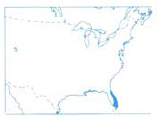
DARLING-PLUM (Reynosia septentrionalis) leaves are evergreen, leathery, opposite, 1 to 1.5 inches long and 0.5 to 0.8 of an inch wide, usually oblong, with a notched or round, bristle-tipped apex. Greenish-yellow flowers, in small axillary clusters, produce dark-purple fruits, 0.5 of an inch long, with a pointed tip. Bark reddish brown and scaly; wood heavy. A shrub or small tree, to 25 feet tall and 9 inches in diameter.


SPINY CEANOTHUS (Ceanothus spinosus) has alternate, elliptical to oblong, evergreen leaves, about 1 inch long and 0.5 of an inch wide, with a stout midrib and pinnate venation. On young shoots, leaves are generally larger and have three palmate veins. Blue, fragrant flowers, resembling lilacs, are borne in dense clusters 5 to 6 inches long. Bark greenish on branches and trunks of small trees; reddish brown on older trunks. A shrub or small tree, to 20 feet tall and about 6 inches in diameter, with a narrow, open crown of slender, angled branches, often with spiny tips.

BLUEBLOSSOM (Ceanothus thyrsiflorus) has alternate, oblong to oblong-ovate, evergreen leaves, 1 to 1.5 inches long, 0.5 to 1 inch wide, slightly hairy on underside; fine marginal teeth, 3 prominent palmate veins. Flowers, blue or occasionally white, in 2- to 3-inch axillary clusters. Fruits black, 3-lobed. A shrub or small tree, to 20 feet tall, 8 inches in diameter. Bark greenish on young trunks and branches; reddish brown on larger, older trunks.
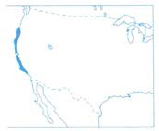
FELTLEAF CEANOTHUS (Ceanothus arboreus) leaves are alternate, elliptical to broadly ovate, with rounded marginal teeth; dark green above, lighter and densely hairy below, prominently 3-veined; 2.3 to 4 inches long, 1 to 2.5 inches wide. Flowers pale blue, in dense axillary clusters 3 to 4 inches long, 1.5 to 2 inches wide. Black fruit, 0.3 of an inch in diameter. To 25 feet tall, 10 inches in diameter, with stout branches. Greenish bark becomes gray on older trunks.

SOLDIERWOOD (Colubrina elliptica) leaves are alternate, 2.5 to 3 inches long, 1.5 to 2 inches wide; elliptical to lanceolate; yellow-green with stout midrib; persist until second season. Yellow flowers in small axillary clusters. Capsules oval, dark orange-red, 3-valved, 0.3 of an inch in diameter. Thin, orange-brown bark peels off in large, papery scales, leaving light patches on trunk. To 60 feet tall, 4 inches in diameter. Coffee Colubrina (C. arborescens), found in same area, has leathery leaves hairy below.
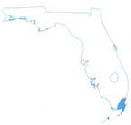
SOME INTRODUCED BUCKTHORNS
GLOSSY BUCKTHORN (Rhomnus frangula), also from Europe, is generally a shrub. Twigs lack thorns but are somewhat hairy.
EUROPEAN BUCKTHORN (Rhamnus cathartica) is a shrub or small tree, resembling Cascara and Carolina buckthorns. Twigs often spiny.

CANELLA FAMILY (Canellaceae)
CANELLA (Canella winterana) leaves are evergreen, leathery, alternate, 3 to 5 inches long, 1 to 2 inches wide; apex rounded, margins smooth. White to purplish flowers, 0.1 of an inch in diameter, produce fleshy, bright-red berries, 0.5 of an inch in diameter, each with 2 to 4 seeds. Outer bark gray; yellow inner bark is source of commercial cinnamon. To 25 feet tall, 10 inches in diameter.
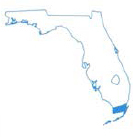
SOAPBERRY FAMILY (Sapindaceae)
This large family of trees and shrubs is primarily tropical. Chinese Lychee (Litchi chinensis), from which lychee nuts are obtained, is a well-known foreign member of the family. Mexican-buckeye (Ungnadia speciosa) is a shrub or small tree ranging into Mexico.
WINGLEAF SOAPBERRY (Sapindus saponaria) leaves are evergreen, alternate, pinnately compound, 6 to 7 inches long. The 5 to 9 leathery leaflets (terminal leaflet sometimes lacking) are smooth-margined. Leaf stem winged between leaflets. Small, white flowers in panicles, to 12 inches long, appear in fall. Globular, orange-brown berries, 0.8 of an inch in diameter, have thin, juicy several-seeded flesh; when crushed, serves as a soap substitute. Bark gray, roughened, scaly. To 45 feet tall, 12 inches in diameter.

FLORIDA SOAPBERRY (Sapindus marginatus) resembles and is often considered synonymous with Wingleaf Soapberry. Leaf stems are narrowly winged or wingless, with 7 to 13 leaflets. To 25 feet tall.

WESTERN SOAPBERRY (Sapindus drummondii) leaves are deciduous, even-pinnately compund; 8 to 18 leaflets 2 to 3 inches long, 0.3 to 0.8 of an inch wide, hairy below. Flower panicles 6 to 9 inches long. Yellow berries, 0.5 of an inch in diameter, turn black; may hang through winter. To 50 feet tall, 2 feet in diameter; bark scaly, reddish brown.

INKWOOD (Exothea paniculata) leaves are evergreen, alternate, pinnately compound, the 2 to 6 wavy-margined leaflets 4 to 6 inches long, 1.5 to 2 inches wide. Flowers white. Fleshy berry purple (occasionally orange), 0.5 of an inch long. Bark reddish brown, scaly. To about 30 to 40 feet tall, 1 foot in diameter.


This family, consisting of over 40 genera with several hundred species of herbs, shrubs, and trees, is best represented in the tropics and regions south of the equator. One genus of trees—linden, or basswood (Tilia)—is widely distributed over parts of the Northern Hemisphere and includes four species native to eastern North America. They are distinctive for their simple, alternate, broadly ovate, deciduous leaves with coarsely toothed margins and unequally heart-shaped bases. The small clusters of creamy-white flowers develop later into nutlike fruits that hang on slender stalks attached to a narrow, leafy bract. Cordage was made from the tough inner bark by American Indians. An herbaceous Asiatic genus (Corchorus) is a source of jute, a widely used fiber.
AMERICAN BASSWOOD (Tilia americana) has the largest leaves, 5 to 6 inches long and 3 to 4 inches wide, of the native American lindens, or basswoods. The few-flowered clusters, each flower, 0.5 of an inch long, and the nutlike fruits, 0.3 of an inch in diameter, are attached to a leafy bract 4 to 5 inches long and 0.5 to 0.8 of an inch wide. On large trees the dark-gray bark is ridged and furrowed. American Basswood grows 60 to 80 feet tall and 2 to 3 feet in diameter. Its wood is light and strong. The tree is valued most as a shade and ornamental tree and for the flavor of honey from its flowers.
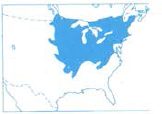
CAROLINA BASSWOOD (Tilia caroliniana) leaves are 3 to 4 inches long and 2.5 to 5 inches wide, often hairy-brown on the underside. The flower clusters contain 8 to 15 blossoms. The nutlike fruits, also covered with rust-colored hairs, are 0.1 of an inch long, smaller than American Basswood’s.

FLORIDA BASSWOOD (Tilia floridana) is similar to and noted as synonymous with Carolina Basswood in 1979 Checklist (see here). Leaves are hairy-brown in spring but smooth, and occasionally silvery on underside, at maturity. Grows to 50 feet tall and 15 inches in diameter.
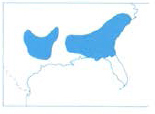
WHITE BASSWOOD (Tilia heterophylla) grows to 80 feet tall and 2.5 feet in diameter. The finely toothed leaves are 3.5 to 5 inches long and 2 to 3 inches wide; they are densely covered with white to brownish hairs on lower surfaces. Numerous (10-24) flowers are borne in each cluster. White Basswood’s nutlike fruits are somewhat hairy.


This family of several hundred species of largely evergreen trees includes the commercial tea plant (Thea sinensis) and also the camellias, prized ornamentals. The family is primarily Asiatic, but includes several small trees in southeastern United States, all with simple, alternate leaves. The rare Franklinia (Franklinia alatamaha) has not been recorded in nature since 1790, when it was found along the Georgia coast. It is believed to exist now only in cultivation.
LOBLOLLY-BAY (Gordonia lasianthus) has leathery, oblong to lanceolate, evergreen leaves, 4 to 6 inches long and 1.5 to 2 inches wide, with finely toothed margins; turn scarlet before falling. Long-stemmed, fragrant, white flowers, 2 to 2.5 inches in diameter, produce a hairy, ovoid, woody capsule, 0.8 of an inch long. Reddish-brown bark is broken into scaly ridges. Short-lived; to 70 feet tall, 20 inches in diameter.
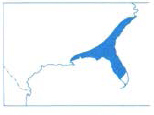
MOUNTAIN STEWARTIA (Stewartia ovata) has elliptical to oblong, deciduous leaves, 2 to 5 inches long and 1 to 2.5 inches wide, with pointed tips and toothed, hairy margins. Flowers 4 inches in diameter; hairy capsule splits along 5 sutures. A shrub or small tree, to 25 feet tall. Virginia Stewartia (S. malacodendron) is less widely distributed, has smaller leaves.

CACTUS FAMILY (Cactaceae)
Cacti of more than 1,000 species grow largely in arid lands of the Western Hemisphere; a few range northward to British Columbia and southern New England. Most have leaves reduced to spines, photosynthesis occurring in the green, fleshy stems. Large, colorful flowers produced singly; fruit is a fleshy berry, edible in many species. Of native cacti in western North America, Saguaro and a few Mexican species are tree-sized with a single trunk. Organpipe Cactus, Senita, and others are tall but many-stemmed. Key West Cephalocereus (Cephalocereus keyensis) grows to tree size in the Florida Keys.
SAGUARO (Cereus giganteus) has clusters of gray spines, 0.5 to 2 inches long, on 12 to 30 prominent ridges around stout trunk. Funnel-shaped flowers, 4 to 4.5 inches long and 2 to 3 inches in diameter, occur at top of branches; open at night in May and June and have a melon-like odor. Red fruits, 2 to 3.5 inches long, are sweet, edible. Grows 25 to 50 feet tall, 1 to 3 feet in diameter.
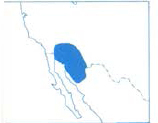
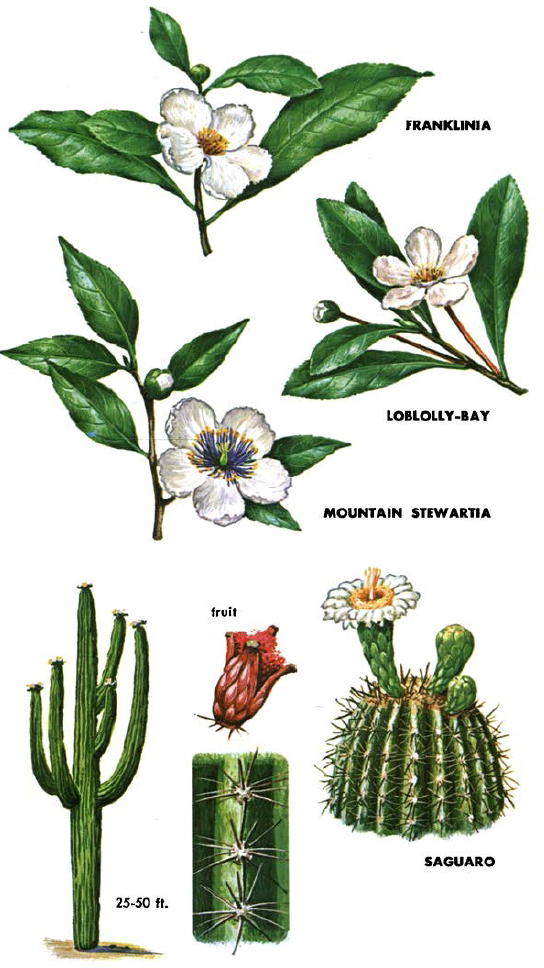
MYRTLE FAMILY (Myrtaceae)
This family contains about 3,000 shrubs and trees native principally to the tropics and Australasia. Many are aromatic. A few species are native to Florida.
STOPPERS, largely in the genus Eugenia, include shrubs or small trees found in various parts of Florida and the Caribbean region. They have simple, opposite, evergreen leaves; white flowers in axillary clusters and berry-like fruits. White Stopper (Eugenia axillaris) leaves are 1 to 3 inches long and 0.5 to 1 inch wide; fruits are bluish black, 0.5 of an inch in diameter. Bark is light brown, ridged, and scaly. It grows to 25 feet tall. Redberry Stopper (Eugenia confusa) has bright red fruits; it grows to 20 feet tall. Red Stopper (Eugenia rhombea), usually a shrub but sometimes a small tree, has red fruits that turn black at maturity. Boxleaf Stopper (Eugenia foefida) has dark red to black fruits and grows to 35 feet tall. Two similar species, usually shrubs but occasionally small trees, are in closely related genera. Long-stalk Stopper (Psidium longipes) has black fruits. Twinberry Stopper (Myrcianthes fragrans) has reddish-brown fruits on long stalks; it may grow to a height of 60 feet.
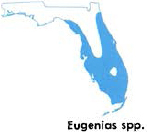
LIDFLOWERS (Calyptranthes spp.) have simple, opposite, evergreen leaves and clusters of small flowers lacking petals. Sepals capped in bud by a lidlike cover, which is shed later. Fruits dry, berry-like, reddish brown. Bark pale white, smooth to scaly. Pale Lidflower or Spicewood (C. pallens) is a shrub or small tree, to 25 feet tall, with leaves 2 to 3 inches long and 0.8 of an inch wide; fruits oblong. Myrtle-of-the-river (C. zuzygium) has smaller, elliptical leaves, nipple-like apex on floral lid, and globular fruits.
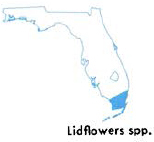
SOME INTRODUCED MEMBERS OF MYRTLE FAMILY
EUCALYPTUS (Eucalyptus spp.) is the most important genus in the myrtle family, with more than 500 species native to Australia. Many are grown in other parts of the world either for wood or as ornamentals. About 75 species have been introduced to California, including Red Ironbark (E. sideroxylong). Manna Gum (E. viminalis), and Bluegum (E. globulus).
CAJEPUT-TREE (Melaleuca quinquenervia), an Australian species, is grown in California and Florida, where it has become naturalized. Bark thick, spongy.
COMMON GUAVA (Psidium guajava), native to Central America, is widely planted in warm regions for its fruit but also grows as an escape. Bark is smooth.

MANGROVE FAMILY (Rhizophoraceae)
This tropical family includes about 60 species of evergreen trees and shrubs that form dense thickets in tidal creeks and estuaries. Soil and debris carried by the tides is washed into the network of stiltlike roots and becomes caught there. Over many years this process slowly extends the shoreline. Mangrove seeds germinate while still attached to the tree. Upon dropping, they float until contacting mud, then begin growth immediately. Bark yields tannin; the wood, charcoal. Commonly associated with Black-Mangrove)
RED MANGROVE (Rhizophora mangle) leaves are leathery, simple, opposite, ovate to elliptical, 3 to 5 inches long and 1 to 2 inches wide. Flowers are pale yellow, 1 inch in diameter and clustered. Fruit is a roughened, conical, rusty-brown berry about 1 inch long, with a short apical tube through which the dartlike radicle of the developing embryo protrudes, becoming 6 to 12 inches long. Bark gray to gray-brown, thick, scaly, and furrowed. Rarely over 20 feet tall in Florida; to 80 feet tall and 2 feet in diameter in tropics.
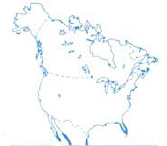
COMBRETUM (WHITE-MANGROVE) FAMILY
(Combretaceae)
Species in this primarily tropical family have leathery, evergreen leaves. Many grow in tidewater flats. Oxhorn Bucida (Bucida buceras) has limited distribution in the Florida Keys. Indian-Almond (Terminalia catappa) is naturalized in southern Florida.
BUTTON-MANGROVE (Conocarpus erectus) leaves are simple, alternate, 2 to 4 inches long and 0.5 to 1.5 inches wide, with smooth margins and a pointed apex. Flowers in dense, globular heads, about 0.3 of an inch in diameter, on panicles 3 to 10 inches long. Tiny, leathery, reddish fruits in conelike heads about 1 inch in diameter. Bark brown to black, in scaly ridges. A shrub or tree, Button-mangrove grows to 60 feet tall and 2 feet in diameter.

WHITE-MANGROVE (Laguncularia racemosa) has simple, opposite leaves, 1 to 3 inches long and 1 to 1.5 inches wide, with a rounded or notched apex, red petioles, and glandular swellings along margin. Greenish-white flowers borne in 1.5- to 2-inch spikes. Fruit about 0.5 inch long, 10-ribbed, obovoid, leathery, reddish brown. Bark reddish brown, ridged, and scaly. A sprawling shrub in Florida, but may grow 60 feet tall in parts of the tropics.


DOGWOOD FAMILY (Cornaceae)
About 100 species, found primarily in the temperate regions, constitute the dogwood family. Two genera represented in the United States and Canada. Dogwoods (Cornus), the most familiar, include the diminutive Bunchberry (C. canadensis), a small herbaceous plant of spongy forest soils, and three species that are usually shrubs but sometimes reach tree size—two western species, Western Dogwood (C. occidentalis) and Blackfruit Dogwood (C. sessilis); and one eastern, Stiffcornel Dogwood (C. stricta). Wavyleaf Silktassel (Garrya elliptica) is a shrub or rarely a small tree on the Pacific coast.
FLOWERING DOGWOOD (Cornus florida) has simple, opposite, deciduous leaves, 3 to 6 inches long and 1.5 to 2 inches wide, usually oval with a pointed apex and with primary veins curving upward along smooth, wavy margins. Scarlet in fall. Small, greenish-white flowers are in compact heads, surrounded by four large, white (occasionally pink or rose), petal-like bracts, notched at apex. Clusters often erroneously considered to be single flowers. Bright-red, ovoid fruits, about 0.5 of an inch long and 0.3 of an inch in diameter, also clustered. Smooth, dark-brown to black bark of young trees breaks up into small, scaly blocks at maturity. Flowering Dogwood, often cultivated as an ornamental, grows 15 to 40 feet tall, 6 to 18 inches in diameter. It has a rounded, rather bushy crown and hard, heavy wood. Prefers moist, rich soils.
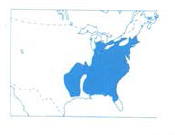
ALTERNATE-LEAF DOGWOOD (Cornus alternifolia) leaves resemble those of other dogwoods but are alternate. White flowers, in loose, flat-topped clusters (cymes), rather than heads. Fruits deep blue to black, 0.3 of an inch in diameter. Bark of young trees is dark reddish brown, smooth; on older trees, fissured. Alternate-leaf Dogwood is a shrub or small tree, growing to 30 feet tall and 8 inches in diameter. It has a broad, flattened crown.

ROUGHLEAF DOGWOOD (Cornus drummondii) has opposite leaves, rough above and woolly below. Flowers and fruit white, in open clusters. A shrub or small tree.
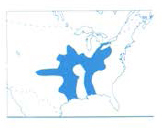
RED-OSIER DOGWOOD (Cornus stolonifera) resembles Roughleaf Dogwood but has reddish twigs. Usually a shrub, rarely growing to small-tree size. It commonly occurs along watercourses and in similar moist locations.

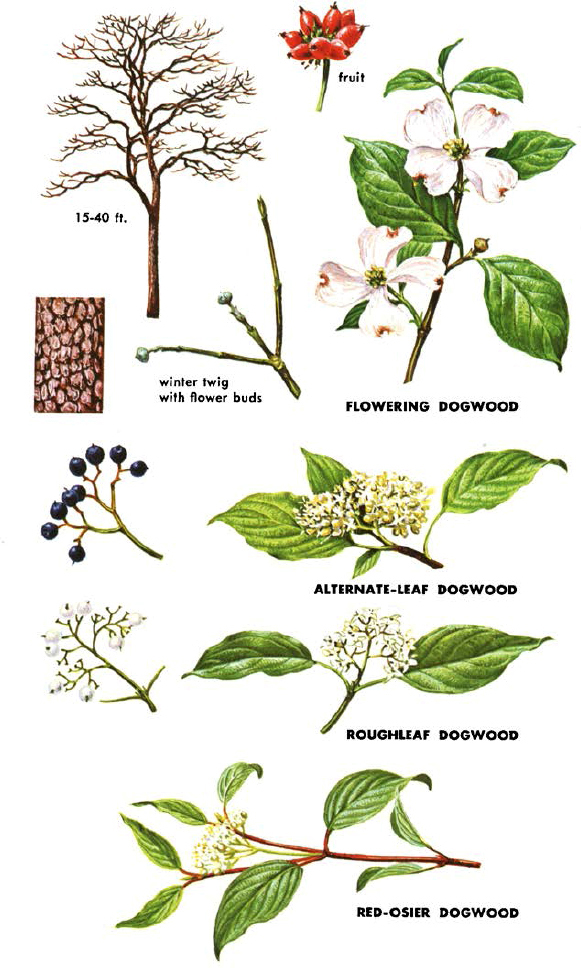
PACIFIC DOGWOOD (Cornus nuttallii) leaves resemble Flowering Dogwood’s but are larger and more ovate, 4 to 6 inches long and 1.5 to 3 inches wide. Greenish-white flowers, in larger heads, are surrounded by 4 to 6 bracts, not notched at apex; bright-red, ellipsoidal fruits in larger clusters. Dark-brown to black bark normally smooth, but breaks into scaly plates at base of large trees. Medium-sized to 60 feet tall and 2 feet in diameter, with a narrow, pyramidal crown. Pacific Dogwood grows at low elevations in shaded, coniferous forests. It is a popular ornamental.

TUPELO FAMILY (Nyssaceae)
Ten species in three genera make up this small family, closely related to dogwood family. Represented in North America only by tupelos, or black gums (Nyssa). The two other genera in the tupelo family occur in eastern Asia.
BLACK TUPELO (Nyssa sylvatica) has simple, alternate, usually obovate, deciduous leaves, 2 to 5 inches long and 1 to 3 inches wide, with smooth margins. Leaves, often clustered near ends of lateral branches, turn scarlet very early in fall. Small, greenish flowers are on separate stalks—the staminate in dense clusters and the pistillate few-flowered. Dark-blue ovoid fruit, about 0.5 of an inch long, has thin flesh surrounding indistinctly ribbed seed. Bark is gray-brown and commonly in small, rectangular blocks. Young twigs greenish yellow, becoming gray to reddish brown. Grows 60 to 90 feet tall, 2 to 3 feet in diameter, mainly in moist soils.

WATER TUPELO (Nyssa aquatica) is similar to Black Tupelo but has larger leaves, 5 to 7 inches long and 2 to 4 inches wide, margins occasionally toothed. Fruit 1 inch long, the seed more prominently ribbed. Grows best in swampy situations, usually standing in water several feet deep during wet season. Base of trunk is usually swollen or buttressed, similar to Baldcypress.

OGEECHEE TUPELO (Nyssa ogeche) resembles Water Tupelo but differs in having less sharply pointed leaves and short-stalked, red fruits, 1 to 1.5 inches long. Seed has winglike ribs. Usually a shrub, occasionally a small tree. Bear Tupelo (Nyssa ursina), also most commonly a shrub, grows in northwestern Florida.


HEATH FAMILY (Ericaceae)
Members of the heath family, more than 1,500 species, grow in acid soils in temperate regions throughout the world. All have simple and, in most, alternate leaves. Most are shrubs. Blueberries, cranberries, rhododendrons, and heathers are among the great variety of familiar plants in this family.
PACIFIC MADRONE (Arbutus menziesii) leaves are evergreen, leathery, oval to oblong, 3 to 6 inches long and 2 to 3 inches wide. The white, urn-shaped flowers, 0.3 of an inch long, are in drooping panicles 5 to 6 inches long. Fruits are orange or red, mealy, and berry-like, about 0.5 of an inch in diameter. Reddish-brown bark peels into thin, irregular sections exposing greenish-brown inner bark; scaly at base of large trees. To 100 feet tall and 4 feet in diameter, with varied form.
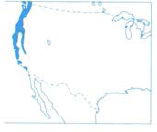
TEXAS MADRONE (Arbutus texana) leaves are evergreen, oval to lanceolate, 1 to 3 inches long and 0.8 to 1.5 inches wide. The flower clusters are 2.5 inches long, and the dark-red fruits are 0.3 of an inch in diameter. The bark is reddish brown. A rare tree with a crooked trunk, Texas Madrone grows about 20 feet tall and 10 inches in diameter, in dry soils.
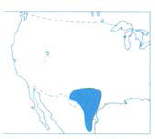
ARIZONA MADRONE (Arbutus arizonica) resembles Texas Madrone in form, size, habitat, and size of flower and orange-red fruit clusters. But the evergreen leaves are lanceolate, 1.5 to 3 inches long and 0.5 to 1 inch wide. On trunks of older trees the bark is ash gray and scaly.

SOURWOOD (Oxydendrum arboreum) leaves are simple, alternate, elliptical, 5 to 7 inches long and 1 to 3 inches wide, margins finely toothed; turn scarlet. White, urn-shaped flowers, about 0.3 of an inch long, are in 1-sided, clustered racemes. Fruits are 5-angled, gray capsules. Bark gray, tinged with red; scaly and furrowed at base. Sourwood occasionally grows to 60 feet tall but is usually smaller.

TREE LYONIA (Lyonia ferruginea) has leathery, evergreen leaves, 1 to 3 inches long and about 1 inch wide, usually tipped with a stiff point. White, globular flowers, 0.1 of an inch in diameter, are small, auxiliary clusters. The fruit is a light-brown capsule about 0.5 of an inch long. Bark on twisted trunk reddish brown, scaly, and ridged. Shrub or small tree, to about 15 feet tall and 10 inches in diameter. Its relative Staggerbush (L. mariana) is poisonous to livestock.


PACIFIC RHODODENDRON (Rhododendron macrophyllum) has oblong, leathery, evergreen leaves, 3 to 10 inches long, 1.5 to 2.5 inches wide, with smooth margins that are characteristically turned under. The flowers, 1.5 inches long, are white to pink, trumpet-shaped, and in compact clusters about 5 inches in diameter at ends of branches. The fruits are reddish-brown capsules about 0.5 of an inch long. Bark reddish brown. Usually a shrub, rarely to 25 feet.
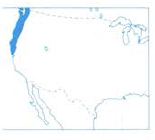
ROSEBAY RHODODENDRON (Rhododendron maximum) resembles Pacific Rhododendron but has oval to obovate leaves, 4 to 12 inches long, 1.5 to 2.5 inches wide, often whitish below. Fruits slim, sticky. Usually a sprawling, twisted shrub, forming dense thickets. Rarely to 40 feet tall, 1 foot in diameter. Catawba Rhododendron (R. catawbiense), more southern and not as tall, has broader leaves and light-purple flowers.
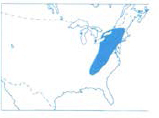
ELLIOTTIA (Elliottia racemosa) leaves are deciduous, ovate to oblong, 3 to 4 inches long, 1 to 2 inches wide, with smooth margins, hairy below. White flowers, with 4 narrow petals, are in erect, terminal panicles. Fruit is a dry, 4-celled (rarely 3 or 5), globular capsule, about 0.3 of an inch in diameter. Bark smooth, gray-brown. A rare shrub or small tree, to 20 feet tall, 6 inches in diameter.

MOUNTAIN-LAUREL (Kalmia latifolia) has leathery, elliptical to lanceolate, evergreen leaves, 3 to 4 inches long and 1 to 1.5 inches wide, alternate or in whorls. Deep pink to white, starlike flowers nearly 1 inch in diameter occur in compact clusters at ends of branches. Each produces a 5-celled capsule about 0.5 of an inch in diameter and ending in a slender style. Grows in moist soils, commonly forming thickets. Usually a shrub; rarely reaches a height of 30 feet and a diameter of 1 foot. Bark reddish brown and scaly.

TREE SPARKLEBERRY (Vaccinium arboreum) leaves are deciduous in North but persistent in South, oval to oblong, 1 to 3 inches long, 1 inch wide. Bell-shaped white flowers in axillary racemes produce tart, shiny-black, globular berries about 0.3 of an inch in diameter. Bark dark brown, ridged, and shreddy. Tree Sparkleberry is a sprawling shrub or small, crooked tree, growing to 30 feet tall and 10 inches in diameter.
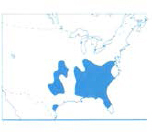
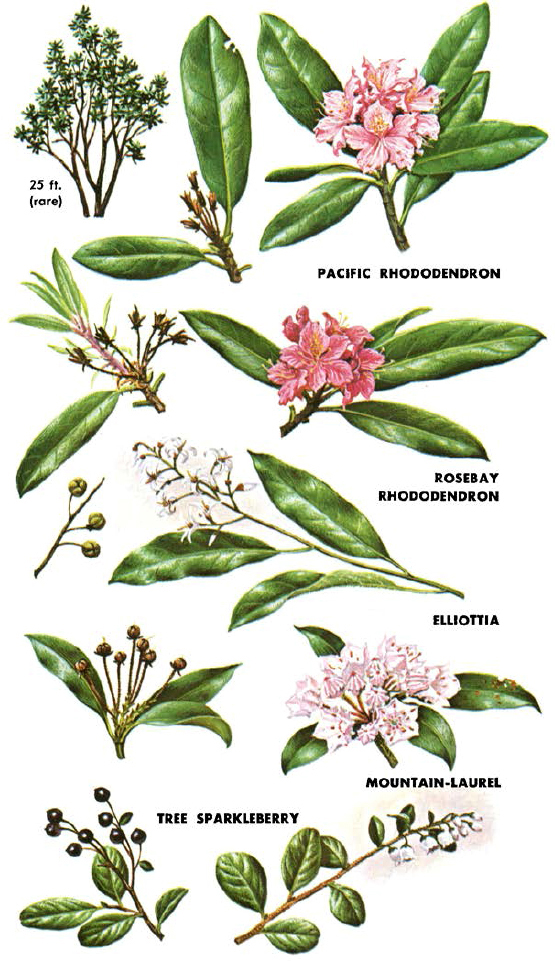
GINSENG FAMILY (Araliaceae)
DEVILS-WALKINGSTICK (Aralia spinosa) has alternate, odd-bipinnately compound, deciduous leaves, 2 to 4 feet long and 2 to 3 feet wide, with spiny stalks. Each leaflet has a terminal and several pairs of opposite, ovate subleaflets, with a tapered apex and toothed margins, 2 to 4 inches long and 1.5 inches wide; mid-vein often spiny below. Small, white flowers in compound, terminal clusters, to 4 feet long, with yellowish stems. Fruit black, berry-like, and juicy, 0.3 of an inch in diameter. Coarse twigs bear stout spines. Bark brown, ridged, furrowed; inner bark yellow. Grows rapidly, to 30 feet tall and 10 inches in diameter, usually in moist soils.
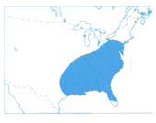
MELASTOME (MEADOW BEAUTY) FAMILY (Melastomataceae)
FLORIDA TETRAZYGIA (Tetrazygia bicolor) has simple, opposite, lanceolate, evergreen leaves, 3 to 5 inches long, 1 to 2 inches wide. Dark green above, paler below, with 3 main veins and smooth, thickened, rolled-under margin. White flowers, 0.8 of an inch in diameter, in loose, terminal panicles. Ovoid, purplish fruits, 0.3 of an inch long, constricted at apex. Usually a shrub, Florida Tetrazygia occasionally grows to 30 feet tall and 4 inches in diameter.

MYRSINE FAMILY (Myrsinaceae)
MARLBERRY (Ardisia escallonioides) is a shrub or small tree, to 25 feet tall, with gray to pinkish bark. Leathery, evergreen leaves are simple, alternate, ovate to obovate, 3 to 6 inches long, 1 to 2 inches wide, with many dark dots on undersurface. Fragrant, starlike flowers have 5 petals dotted with red on inner surface; in rusty-haired panicles, to 5 inches long. Shiny-black fruit is round, 0.3 of an inch in diameter, with a sharp point and dotted with resin. Flesh thin and dry.

FLORIDA RAPANEA (Rapanea punctata) has leathery, simple, alternate, oblong to obovate, evergreen leaves, 2 to 4 inches long and 1 to 2 inches wide, notched at apex. Usually crowded near ends of branches. Small axillary clusters of white flowers, about 0.1 of an inch in diameter, are marked with purple; produce globular, dark-blue or black fruit, about 0.2 of an inch in diameter, with pointed apex. A shrub or small tree, to 25 feet tall, with smooth, gray bark.
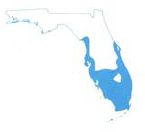

SAPOTE (SAPODILLA) FAMILY (Sapotaceae)
This family of about 500 species of tropical trees and shrubs includes the Central American Sapota, or Sapodilla (Achras zapota), from which chicle for chewing gum is obtained. The fruit is also delicious. Sapodillas grow wild in extreme southern Florida and on the Keys. Gutta percha, a gum, is derived from sap of species from southeastern Asia; other members of the family provide cabinet woods, oils, and other useful products. Only a few species, none of commercial importance, occur in temperate North America.
BUMELIAS (Bumelia spp.) of four tree-sized species are native to southeastern United States.
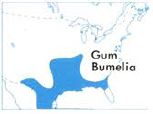
Gum Bumelia (B. lanuginosa) is a small, narrow-crowned tree, to 40 feet tall and 2 feet in diameter. Simple, ovate to oblong, evergreen leaves are alternate, appearing whorled; 1 to 3 inches long, 1 inch wide, with silvery or rust-brown hairs below. Most have blunt or rounded tips, some pointed. Small white flowers, clustered in leaf axils, produce black fruits about 0.5 of an inch long. Bark dark gray to black, scaly, and fissured.

Tough Bumelia (B. tenax), similar but smaller, has shiny, reddish-yellow hairs under leaves and on twigs, which often bear inch-long spines.
Saffron-plum (B. celastrina) leaves are 1 to 1.5 inches long and 0.3 to 1 inch wide. The black fruits are nearly an inch long.

Buckthorn Bumelia (B. lycioides) has deciduous leaves, 3 to 6 inches long and 0.5 to 2 inches wide. Black fruit about 0.8 of an inch long; twigs have curved spines.

FALSE-MASTIC (Mastichodendron foetidissimum), a medium-sized tree with an irregular crown, has simple, alternate, oval, evergreen leaves, 3 to 5 inches long and 1 to 2 inches wide. Tiny, yellow flowers in small, axillary clusters; inch-long, yellow, berry-like fruit has a thick, juicy flesh. Bark reddish brown and scaly.
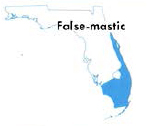
WILLOW BUSTIC (Dipholis salicifolia) has simple, alternate, oblong to lanceolate, evergreen leaves, 3 to 5 inches long, 1 to 2 inches wide. Tiny, white flowers borne in small clusters, usually in leaf axils, have sepals covered with rusty-brown, silky hairs. Globular, leathery, black fruits are 0.3 of an inch in diameter. Bark reddish brown, scaly. Grows 50 feet tall and 18 inches in diameter, with a narrow, graceful crown.


SATINLEAF (Chrysophyllum oliviforme) has simple, alternate, oval, leathery, evergreen leaves, 2 to 3 inches long and 1 to 2 inches wide; shiny, coppery hairs make undersurface like suede. The small, white flowers in axillary clusters produce dark-purple, juicy berries 0.8 of an inch long. Reddish-brown bark is scaly. A shrub or small tree, Satinleaf grows to 30 feet tall, 1 foot in diameter.

WILD-DILLY (Manilkara bahamensis) has simple, alternate, oblong to obovate, leathery, evergreen leaves, clustered at ends of twigs. They are 3 to 4 inches long and 1 to 2 inches wide, waxy above and covered with brown hairs below. Light-yellow flowers, clustered in leaf axils on slender, reddish, hairy stems. Fleshy fruit (berries), 1.5 inches in diameter, have a thick, brown, scaly skin. Each contains one seed surrounded by soft flesh with milky juice. Bark gray to reddish brown, scaly, fissured. To 40 feet tall, 18 inches in diameter, with a short, gnarled trunk.

THEOPHRASTA (JOEWOOD) FAMILY (Theophrastaceae)
JOEWOOD (Jaquinia keyensis) has simple, leathery, evergreen leaves, usually alternate but crowded near ends of twigs. They are 1 to 3 inches long and 0.5 to 1 inch wide, with greatest width above middle and with a rounded, notched, or spined apex. Fragrant, pale-yellow, trumpet-shaped flowers, 0.3 of an inch in diameter, occur in loose racemes, to 3 inches long, at ends of branches. Fruit, 0.3 of an inch in diameter, is an orange-red berry with many seeds. To 15 feet tall and 7 inches in diameter, with smooth, blue-gray bark, commonly mottled.
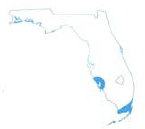
SWEETLEAF FAMILY (Symplocaceae)
The one genus in this family contains about 300 species of shrubs and small trees, one of them native to southeastern United States. Others occur in the West Indies, Asia, and Australia.
COMMON SWEETLEAF (Symplocos tinctoria) has simple, alternate, oblong, leathery leaves, 5 to 6 inches long and 1 to 2 inches wide, with wavy margins. Leaves remain on tree most of year. White, fragrant flowers, 0.3 to 0.5 of an inch long, occur in clusters on silky stalks. Dry, brown, ovoid fruit is 0.5 of an inch long. Bark ash gray, with corky tubercles. A shrub or small tree, to 35 feet tall, 6 inches in diameter.


EBONY FAMILY (Ebenaceae)
Most of the more than 300 species in this family grow in the tropics and subtropics. The most famous is Ebony (Diospyros ebenum), a native of southeastern Asia; it provides the hard black wood used for piano keys and fine furniture.
COMMON PERSIMMON (Diospyros virginiana) has simple, alternate, ovate-oblong, deciduous leaves, 4 to 6 inches long and 2 to 3 inches wide and with smooth margins. Small staminate and pistillate flowers are on twigs of the current year on separate trees; the staminate in few-flowered clusters, the pistillate solitary. The fruit is orange to reddish purple and several-seeded, about 1.5 inches in diameter; astringent when green but sweet and edible when ripe. Bark is almost black, broken into small, rectangular blocks. The Common Persimmon grows to 60 feet tall and 2 feet in diameter, with a divided trunk and broad, rounded crown. It attains its best growth in moist, rich soils.

TEXAS PERSIMMON (Diospyros texana) resembles the Common Persimmon in form but has smaller, obovate leaves, with a rounded apex, hairy below. The flowers are on twigs of the previous season, the smaller fruit is black, and the bark is gray and scaly.

SNOWBELL (STORAX) FAMILY (Styracaceae)
Includes over 100 species of trees and shrubs native to North and South America, eastern Asia, the Malay Archipelago, and the Mediterranean region. Many have attractive flowers.
BIGLEAF SNOWBELL (Styrax grandifolius) has simple, alternate, obovate, deciduous leaves, 2.5 to 5 inches long, 1 to 3 inches wide; margins finely toothed or smooth; veins hairy below. White, 5-lobed, bell-shaped flowers, to 1 inch long, in axillary racemes to 6 inches long. The fruit is dry, oval, and 0.3 of an inch long. Bigleaf Snowbell grows to 40 feet tall and 8 inches in diameter.

SILVERBELLS (Halesia spp.) are three species of deciduous shrubs or small trees. Leaves alternate, oblong to elliptical, hairy below, with toothed margins. Flowers showy, white, bell-shaped, to 2 inches long. Carolina Silverbell (H. carolina) has 4-winged, nutlike fruit; Two-wing Silverbell (H. diptera), 2-winged. Little Silverbell (H. parviflora), usually a shrub, has small flowers. The 4-winged fruit is club-shaped.


OLIVE FAMILY (Oleaceae)
This family, mainly of the Northern Hemisphere includes about 500 species of shrubs and trees. Olives and olive oil are provided by Olea europa, native to the Mediterranean Basin but now cultivated widely. Ashes (Fraxinus) and others are the source of timber. Lilac (Syringa), forsythia (Forsythia), jasmine (Jasminum), and privet (Ligustrum), well-known shrubs of the olive family, are widely used as ornamentals.
FRINGETREE (Chionanthus virginicus) leaves are deciduous, simple, opposite, ovate-oblong, 4 to 8 inches long and 0.5 to 4 inches wide; margins smooth to wavy, veins hairy beneath. Fragrant flowers, with 4 to 6 narrow, white petals, about 1 inch long, borne in clusters, 4 to 6 inches long; flowers dioecious or, rarely, perfect. Dark-purple, oval fruits, about 1 inch long, have thin, dry flesh enclosing one seed (occasionally 2 or 3). The fruit is sometimes covered with a white, powdery wax. Bark brown, scaly. A shrub or small tree, Fringetree grows to 30 feet tall and 1 foot in diameter, with a narrow, oblong crown. Planted as an ornamental.
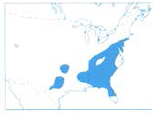
DEVILWOOD (Osmanthus americanus) has simple, opposite, oblong-lanceolate, leathery, evergreen leaves, 4 to 5 inches long and 1 to 1.5 inches wide, with smooth, somewhat curled margins. Small, creamy-white flowers (perfect and unisexual on different plants) in axillary clusters. Fruit oval, dark blue, about 1 inch long, with a thin, fleshy covering over single seed. Bark gray-brown, scaly. A shrub or small, narrow-crowned tree, to 50 feet tall and 1 foot in diameter, with considerable variation in size and color of fruit. Most common near borders of streams and swamps. Also known as wild olive.

SWAMP-PRIVET (Forestiera acuminata) leaves are deciduous, simple, opposite, elliptical, 2 to 4 inches long and 1 to 1.5 inches wide, with small, widely spaced teeth above middle. Dioecious; small clusters of pistillate and yellowish-green staminate flowers, lacking petals, appear before leaves. Fruit is dark purple, narrowly oblong, 1 to 1.3 inches long, with thin, dry flesh enclosing one seed. Bark dark brown, ridged. Swamp-privet is a shrub or small tree, to 25 feet tall, usually in moist soils. Texas Forestiera (F. angustifolia), Florida-privet (F. segregata), and Desert-olive (F. phillyreoides), also shrubs or small trees, occur in southwestern United States.
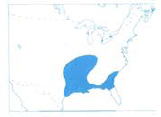
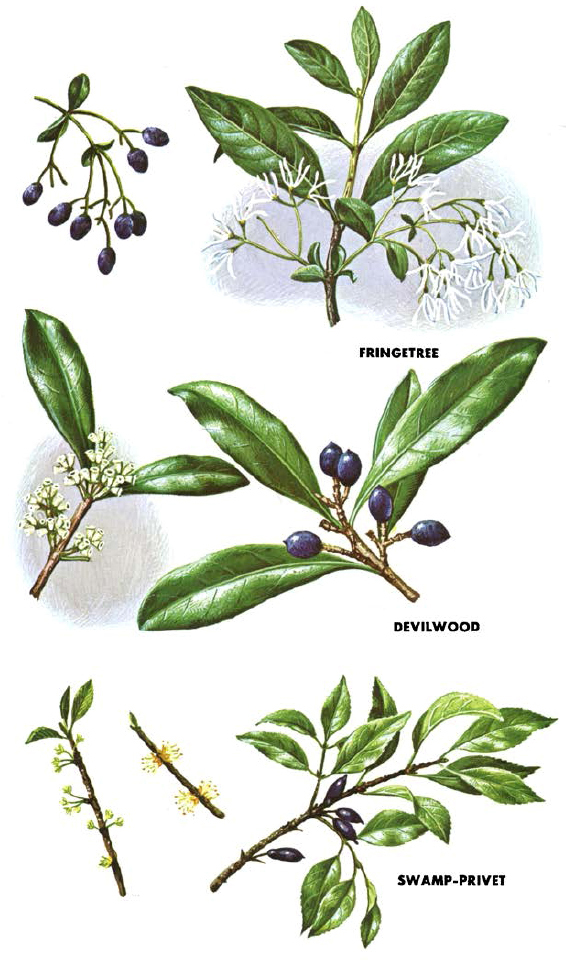
ASHES (fraxinus)
Approximately 65 species of trees and shrubs belong to the genus Fraxinus in the olive family. Largely confined to temperate regions of Northern Hemisphere, but a few occur in the tropics. In addition to trees described here, four small trees, usually shrubby, grow in southwestern U.S. southward into Mexico—Berlandier Ash (F. berlandieriana), Two-petal Ash (F. dipetala), Goodding Ash (F. gooddingii), and Chihuahua Ash (F. papillosa).
Ashes are easily recognized as a group, but species are difficult to distinguish. Leaves are deciduous, opposite, and, with few exceptions, odd-pinnately compound. Some species are dioecious; others have polygamous or perfect flowers in clusters (panicles), appearing before or with the leaves. Flowers of most North American species lack petals; one has flowers with showy white petals. Fruit is a samara, with single terminal wing. In winter, naked twigs have blunt buds (terminal larger than lateral) with 1 to 3 pairs of exposed scales. In most species, the leaf scars are notched and half-round, with an elliptical line of tiny, vascular bundle scars.
WHITE ASH (Fraxinus americana) leaves are 8 to 12 inches long, usually with 7 (sometimes 5 to 13) oval to oblong-lanceolate leaflets, 3 to 5 inches long and 1.5 to 3 inches wide; margins smooth or finely toothed, essentially glabrous below. Stems of leaflets are very long and slender. Dioecious, flowers appearing before leaves. Samaras 1 to 2 inches long, with wing extending only part way along seed. Twigs round, usually not hairy, with half-round, notched leaf scars. White Ash has gray bark, with diamond-shaped ridges appearing on the trunks of older trees. To 80 feet tall, 3 feet in diameter.
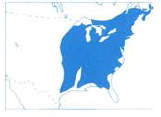
GREEN ASH (Fraxinus pennsylvanica) resembles White Ash but has slightly smaller leaves, 6 to 9 inches long, with leaflets 3 to 4 inches long and 1 to 1.5 inches wide. Margins of the leaflets are toothed above the middle. The underside of the leaflets may be smooth to hairy. In addition, the dioecious flowers of Green Ash appear after the leaves have begun to unfold.

PUMPKIN ASH (Fraxinus profunda) has leaves 9 to 18 inches long. The lanceolate to elliptical, usually smooth-margined leaflets are 5 to 8 inches long and 1.5 to 4 inches wide; they are hairy below, especially on midribs and veins. Leaf stems and twigs also hairy. Pumpkin Ash samaras are 2 to 3 inches long and 0.5 of an inch wide, with the wing extending below the middle of the seed.


BLACK ASH (Fraxinus nigra) leaves are 12 to 16 inches long. They have 9 (sometimes 7 to 13) stemless, oblong to oblong-lanceolate leaflets, 4 to 5 inches long and 1.5 inches wide, with finely toothed margins; essentially glabrous below. Polygamous flowers appear before the leaves. Samaras are oblong to elliptical, 1 to 1.8 inches long, with a thin wing extending below the center of the indistinct seed cavity. Grows to 90 feet tall, 2 feet in diameter.
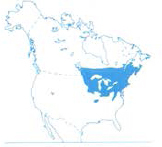
BLUE ASH (Fraxinus quadrangulata) twigs are distinctly 4-angled. The leaves, 8 to 12 inches long, have 5 to 11 stalked lanceolate to oblong-lanceolate leaflets, 3 to 5 inches long and 1 to 2 inches wide; margins toothed. Flowers are perfect. Samaras are oblong-ovate, 1 to 2 inches long with a thin wing extending to the base of the seed. Blue Ash grows to 60 feet tall and 2 feet in diameter. During pioneer days, a blue dye was obtained from the inner bark.

SINGLELEAF ASH (Fraxinus anomala) has simple (occasionally with 2 to 3 leaflets), long-stalked, broadly oval leaves, 1.5 to 2 inches long and 1 to 2 inches wide, with margins entire or toothed above middle. Polygamous flowers appear when leaves are nearly grown. Samaras, to 0.8 of an inch long, have a broad wing extending around seed. The twigs are 4-angled. Singleleaf Ash is a shrub or small tree, growing to 20 feet tall and 6 inches in diameter. Often occurs in dry or rocky soils.
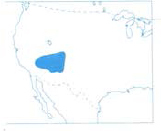
TEXAS ASH (Fraxinus texensis) leaves are 5 to 8 inches long. The 5 (occasionally 7) long-stalked, oval to obovate leaflets are 1 to 3 inches long and 1 to 2 inches wide, with toothed margins and tufts of white hair in axils of veins below. Dioecious flowers appear as leaves unfold. Spatulate samara, to 1 inch long, has a seed nearly round in cross section. To 50 feet tall and 3 feet in diameter.
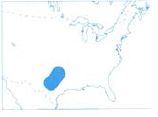
CAROLINA ASH (Fraxinus caroliniana) leaves are 7 to 12 inches long. The 5 to 7 long-stalked, oblong-ovate leaflets are 3 to 6 inches long and 2 to 3 inches wide, with coarsely toothed margins. Glabrous below. Dioecious flowers appear before leaves. Samaras are to 3 inches long, the thin, broad wing surrounding seed sometimes 3-winged. Bark scaly, light gray. To 40 feet tall, 1 foot in diameter.

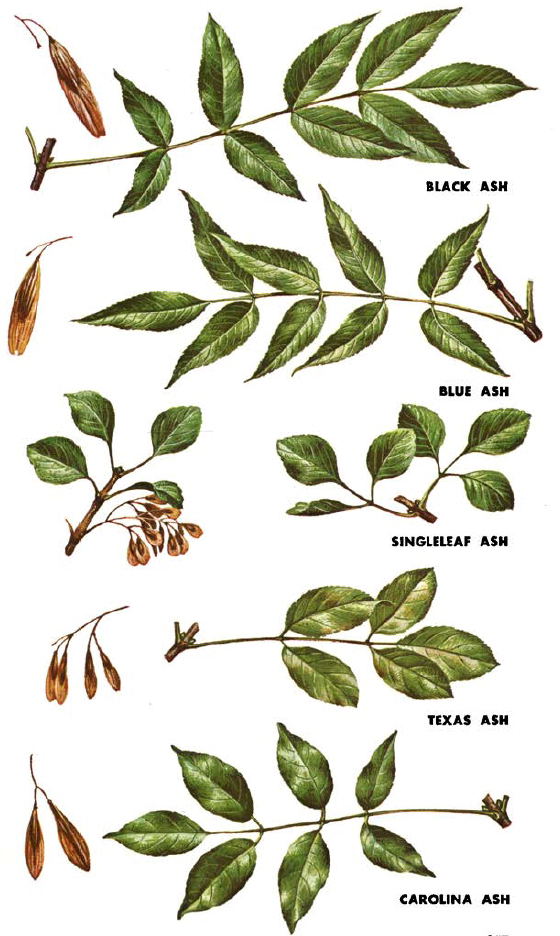
GREGG ASH (Fraxinus greggii) leaves are 1.5 to 3 inches long, with winged main stem; they remain on the tree through the winter, until flowering time. The 3 to 7 leathery, obovate leaflets are 0.5 to 1 inch long and 0.3 of an inch wide; margins are smooth or inconspicuously toothed and the pale-green underside is marked with black dots. Polygamous flowers appear before the leaves. Samara is spatulate, to 0.8 of an inch long, with a broad wing extending to about the middle of the seed. A shrub or small tree, to 20 feet tall and 8 inches in diameter.

VELVET ASH (Fraxinus velutina) leaves are 3 to 6 inches long, with 5 (sometimes 3 to 9) elliptical to lanceolate leaflets, 1 to 2 inches long and to 1 inch wide; margins entire or finely toothed above the middle and often hairy below. Dioecious, the flowers appearing in spring before or with the leaves. The samara is obovate to elliptical, to 1 inch long, with wing extending only part way along the seed. Velvet Ash attains a height of 30 feet and a diameter of 1 foot. Its gray bark is ridged and furrowed.

OREGON ASH (Fraxinus latifolia) leaves are 5 to 14 inches long, with 5 to 7 (occasionally 9) ovate to obovate leaflets, 3 to 6 inches long and 1 to 1.5 inches wide, with smooth or finely toothed margins; usually slightly hairy below and lateral leaflets often stemless. Dioecious flowers appear with leaves. Samara elliptical to oblanceolate, to 1.5 inches long, with wing extending to middle of seed. Oregon Ash grows to 75 feet tall and 3 feet in diameter. In moist, fertile soils, it has a long, clear trunk, but on poorer soils, its form is often crooked and ragged.

FRAGRANT ASH (Fraxinus cuspidata) leaves are 3 to 7 inches long, with 3 to 7 long-stalked, lanceolate to ovate leaflets, 1.5 to 2.5 inches long and to 0.8 of an inch wide; margins entire or with widely spaced teeth above the middle. Perfect flowers appear with leaves; they differ from most ashes in being fragrant and having showy white petals. Samaras are elliptical to oblong-ovate, to 1 inch long, with wing extending nearly to the base of the seed. Scattered lenticels mark the reddish-brown twigs; bark of larger trunks is gray. A shrub or small tree, to 20 feet tall and 8 inches in diameter. A variety (F. cuspidata var. macropetala) has broader leaflets with entire margins, and occasionally its leaves are simple.


BORAGE FAMILY (Boraginaceae)
The 90 genera and some 1,500 species of trees, shrubs, and herbs in this family are found primarily in warm regions. The family is represented most abundantly in the Mediterranean area and in Central Asia. Several species attaining the size of small trees are native to southeastern United States, southern Texas, and southward into Mexico and Central America. Heliotropes and forget-me-nots are familiar flowers of the borage family.
BAHAMA STRONGBARK (Bourreria ovata) has alternate, ovate to obovate, smooth, evergreen leaves, 2 to 3 inches long and 1 to 2 inches wide; margins smooth and apex rounded, notched, or pointed. Leaves hairy when young. White, bell-shaped flowers, 0.8 of an inch in diameter, in terminal clusters. Calyx of flower remains attached to orange-red fruit, 0.5 of an inch in diameter. Bark brownish gray, with thin scales. Bahama Strongbark grows in moist soils, to 35 feet tall and 1 foot in diameter, with a fluted trunk and an irregular, rounded crown. Rough Strongbark (B. radula), usually a shrub, is similar to Bahama Strongbark, but its leaves are rough textured; fruit orange.

GEIGER-TREE (Cordia sebestena) has simple, alternate, ovate, evergreen leaves, 5 to 6 inches long and 3 to 4 inches wide, with margins smooth or coarsely toothed above middle. Apex usually pointed; stout stem and underside of principal veins hairy. Trumpet-shaped, bright-orange flowers, 0.7 of an inch long and 1 to 1.5 inches across, in terminal clusters; hairy exterior. Fruit ivory, 1.3 inches long and 0.8 of an inch in diameter, with tail-like appendage at apex. Bark dark brown to black, ridged, scaly. Geiger-tree is a shrub or small tree, to 30 feet tall and 6 inches in diameter. Anacahuita (C. boissieri), a rare tree of southern Texas and Mexico, has white flowers, and calyx enclosing fruit is ribbed.
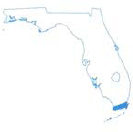
ANAQUA (Ehretia anacua) almost evergreen, has tardily deciduous, simple, alternate, oval to oblong leaves, 3 to 4 inches long and 2 to 3 inches wide. The apex is pointed, and the margins are toothed above the middle. Small, white flowers occur in loose terminal clusters about 2 inches long; blooms in late winter and spring. Fruit, 0.3 of an inch in diameter, is light yellow to red, fleshy, and edible. Brownish-gray bark is scaly. Anaqua grows to 50 feet tall and 3 feet in diameter, with stout branches forming round-topped crown.


VERBENA FAMILY (Verbenaceae)
Shrubs and trees are included in the 80 genera and 1,200 species of largely herbaceous plants. Teak (Tectona grandis) is one of several valuable timber trees in this family.
BLACK-MANGROVE (Avicennia germinans) has opposite, oblong to elliptical, evergreen leaves, 2 to 3 inches long and 0.8 to 1.5 inches wide, with smooth, slightly curled margins; they are hairy below. White, 4-lobed flowers, 0.3 to 0.5 of an inch across, are in terminal clusters to 1.5 inches long. Fruit is a compressed, 2-valved and 1-seeded capsule, to 1.5 inches long and 1 inch wide. Bark of larger trees is dark reddish brown and scaly, with orange-red inner bark sometimes exposed between the scales. Forms dense thickets just inshore of Red Mangrove. In Florida and adjacent Gulf Coast areas, a shrub or small tree, to 30 feet tall and 6 inches in diameter. To 70 feet tall in parts of wide range.
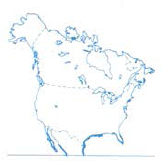
FLORIDA FIDDLEWOOD (Citharexylum fruticosum) leaves are evergreen, simple, opposite, oblong to obovate, 3 to 4 inches long and 1 to 1.3 inches wide, with curled margin. Small, white, fragrant flowers are tubular, with small, rounded petals; in axillary racemes 2 to 4 inches long. Blooms throughout year. Lustrous reddish-brown to black fruit, 0.3 of an inch in diameter, has thin, sweet, juicy flesh. Bark reddish brown, scaly. A shrub or small tree, to 30 feet tall, 6 inches in diameter.

NIGHTSHADE FAMILY (Solanaceae)
This is a family of some 85 genera and more than 1,800 species of herbs, vines, shrubs, and trees of temperate and tropical regions. Includes such valuable plants as potato, tomato, eggplant, tobacco, and petunia. Tree Tobacco (Nicotiana glauca) is a South American shrub or small tree naturalized in extreme southern United States.
MULLEIN NIGHTSHADE (Solanum erianthum) leaves are evergreen, simple, alternate, ovate to elliptical, hairy, and with wavy margins. Lower leaves are 5 to 7 inches long, 1 to 3 inches wide; smaller near growing tip. White, starlike flowers in axillary clusters 2 to 4 inches long; fruit yellow, round, 0.5 to 0.8 of an inch in diameter. Greenish to yellowish-gray, warty bark. A shrub or small tree, to 10 feet tall, usually in rich, moist soils. May be a naturalized species.
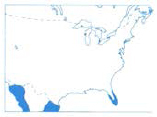

BIGNONIA (TRUMPET CREEPER) FAMILY (Bignoniaceae)
Some 700 species of trees and shrubs belong to this family. Most common in the tropics; a few species occur in temperate regions.
NORTHERN CATALPA (Catalpa speciosa) leaves are deciduous, long-stemmed, heart-shaped; 10 to 12 inches long and 7 to 8 inches wide, whorled or opposite. Tubular, white flowers, marked with purple and yellow, bloom after leaves develop; they are 2 inches long and 2.5 inches wide, in showy, 5- to 6-inch panicles. Each produces a brown capsule, 9 to 20 inches long and 0.5 to 0.8 of an inch in diameter, containing many fringed seeds about 1 inch long. Brown bark often scaly. To 100 feet tall and 4 feet in diameter, usually with a short trunk, stout branches, and a broad, rounded crown.

SOUTHERN CATALPA (Catalpa bignonioides) is smaller (60 feet tall; 3 feet in diameter). Flowers in denser clusters and with more yellow and purple. Capsules have thinner walls.

BLACK-CALABASH (Amphitecna latifolia) leaves are evergreen, leathery, and alternate, widest above middle, 6 to 8 inches long and 1 to 4 inches wide. Creamy-white to dull-purple flowers, 2 inches long, in spring and fall; usually have a disagreeable odor. Oval fruit, 3 to 4 inches long and 1.5 to 2 inches in diameter, has a shiny-green, hard, 4-ridged, and somewhat roughened husk. Contains many seeds about 0.5 of an inch long. Bark reddish brown, scaly. Grows to 30 feet tall.
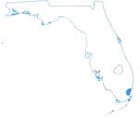
DESERTWILLOW (Chilopsis linearis) leaves are 6 to 12 inches long and 0.3 of an inch wide; deciduous. Tubular, white flowers, tinged with purple and yellow, are 0.8 to 1.5 inches long and in clusters 3 to 4 inches long. Narrow fruit capsule is 7 to 12 inches long. Bark dark brown, ridged, and scaly. To 30 feet tall, 1 foot in diameter, with narrow crown.

AN INTRODUCED SPECIES
ROYAL PAULOWNIA (Paulownia tomentosa) resembles a catalpa, but fragrant, deep-purple flowers appear before leaves. Twigs at first hairy, later smooth. Ovoid, woody capsules, 1 to 1.5 inches long. To 40 feet tall and 1.5 feet in diameter. Native to China; widely planted in the U.S., mainly in southeastern states.

HONEYSUCKLE FAMILY (Caprifoliaceae)
Most of the 275 species in about 10 genera are shrubs; a few attain small-tree size. Some of the shrubs are grown as ornamentals for their fragrant, showy flowers or for their colorful fruit. Represented most abundantly in temperate regions of the world.
ELDERS (Sambucus spp.) of more than 12 species grow in North America. All have opposite, odd-pinnately compound, deciduous leaves, with 5- to 7-toothed leaflets. Pith of twigs is large, spongy. Small, usually white flowers are in elongated or flat-topped clusters, and fruits are about 0.5 of an inch in diameter. Common native species that occasionally attain tree size include Pacific Red Elder (S. callicarpa), with red fruit; Blue Elder (S. cerulea) and American Elder (S. canadensis), with blue fruit; Mexican Elder (S. mexicana), with blue-black fruit; and Blackbead Elder (S. melanocarpa), with black fruit. Velvet Elder (S. velutina), also with black fruit, has hairy leaflets and yellow flowers.
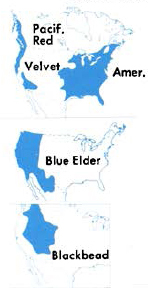
VIBURNUMS (Viburnum spp.) of some 20 species occur in North America. Their leaves are simple, opposite, and usually with toothed margins; in some species turn red in fall. Creamy-white flowers are in flat-topped clusters, 3 to 5 inches across. Fruits, about 0.3 of an inch in diameter, are black or blue. Native species that may attain tree size are Walter Viburnum (V. obovatum), which has scented, stemless leaves; Nannyberry (V. lentago), with sharply toothed leaf margins; Blackhaw (V. prunifolium), which has finely toothed leaf margins; and Possumhaw Viburnum (V. nudum), which usually has smooth leaf margins and long-stalked flower clusters.

COMPOSITE (SUNFLOWER) FAMILY (Compositae)
BIG SAGEBRUSH (Artemisia tridentata) leaves, with a pungent “sage” odor, are 1.5 inches long, alternate, wedge-shaped, and 3-toothed at apex. Small, drab-brownish flowers occur in long, narrow clusters. Usually a gnarled shrub, 4 to 5 feet tall, but grows to small-tree size in fertile bottomlands. Eastern Baccharis (Baccharis halimifolia), found along the Atlantic and Gulf coasts, is the only other native member of the composite family that may be tree-sized. Usually, however, it is a shrub.


MADDER FAMILY (Rubiaceae)
These are mainly tropical trees, shrubs, and herbs forming 350 genera and nearly 6,000 species. Coffee, the South American cinchonas (the bark of which yields quinine), and such ornamentals as Cape Jasmine and gardenias belong to this family. Seven-year Apple (Genipa clusiaefolia), Scarletbush (Hamelia patens), Bahama Balsamo, or Wild Coffee (Psychotria ligustrifolia), and Seminole Balsamo (P. undata) are small trees or shrubs of southern Florida and the Keys.
COMMON BUTTONBUSH (Cephalanthus occidentalis) leaves are deciduous, opposite or whorled, 4 to 7 inches long, 2 to 3.5 inches wide, hairy along mid-vein below. Fragrant flowers in globular heads, 1 to 1.5 inches in diameter, on slender stems 1 to 2 inches long. Seeds in greenish to reddish-brown balls. Bark gray-brown (black on older trees), ridged, scaly. Shrub or small tree, to 30 feet tall, 8 inches in diameter; swampy ground.

CARIBBEAN PRINCEWOOD (Exostema caribaeum) has opposite, orange-stemmed, leathery, evergreen leaves, 1.5 to 3 inches long, 0.5 to 0.8 inches wide. Fragrant, solitary, axillary flowers 3 inches long with 5 narrow petals at apex of a thin tube. Capsule 2-celled, many-seeded, 0.7 of an inch long; black when mature. Bark thin, gray. A shrub or small tree, to 25 feet tall.

ROUGHLEAF VELVETSEED (Guettarda scabra) leaves are leathery, evergreen and opposite, 2 to 5 inches long and 1.5 to 3 inches wide, rusty-hairy below. Flowers white, tubular, about 1 inch long, on slender, few-flowered, axillary stalks. Fruit fuzzy, red at first but purple when ripe; 0.3 of an inch in diameter. To 30 feet tall and 15 inches in diameter; in sandy soil near salt water.
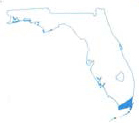
ELLIPTIC-LEAF VELVETSEED (Guettarda elliptica) has silky-haired leaves, 1.0 to 2.5 inches long and 0.5 to 1 inch wide. Creamy-white flowers. To 20 feet tall, 6 inches in diameter.

PINCKNEYA (Pinckneya pubens) leaves are deciduous, simple, opposite, 5 to 8 inches long, 3 to 4 inches wide. Tubular flowers, 2.5 inches long, in few-flowered clusters. Globular capsule 2-celled, about 1 inch long. Bark brown, scaly. Pinckneya grows to 30 feet tall and 10 inches in diameter.


ADDITIONAL EXOTIC SPECIES IN MISCELLANEOUS FAMILIES
HORSETAIL CASUARINA (Casuarina equisetifolia), one of 25 species of the family Casuarinaceae, is native to Australia and nearby lands. Evergreen leaves are tiny, toothlike scales, whorled at joints on the wiry, pale-green, drooping branches. Fruit conelike. Also called Australian-pine, Ironwood, and Beefwood. Naturalized in Florida and California. Grows 100 to 150 feet tall. Similar C. glauca used as a windbreak.

CHINESE PARASOLTREE (Firmiana simplex), of the chocolate family, Sterculiaceae, has 3- to 5-lobed, heart-shaped deciduous leaves, 6 to 12 inches across. Crown rounded. Bark smooth, greenish. Grown in warm parts of North America and now naturalized in Southeast. Native to China and Japan. To 40 feet tall.
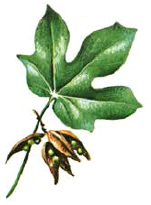
SILK-OAK (Grevillea robusta), in the family Proteaceae, is a native of Australia grown as an ornamental in California, Texas, and northern Florida. May grow 30 to 70 feet tall. Leaves evergreen, fernlike, bipinnately compound, 4 to 12 inches long, silvery below. Flowers yellow to reddish, in clusters 3 to 5 inches long. Wood lustrous, silky.
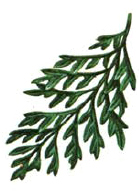
RUSSIAN OLIVE (Elaeagnus angustifolia), in the family Elaeagnaceae and native to Europe and Asia, is widely planted in the United States. Leaves are deciduous, willowlike, 1.5 to 3 inches long, gray-green above and silvery below. Flowers are small, yellowish, fragrant. Fruit is olivelike, 0.4 of an inch long, yellowish-white. To 20 feet tall.
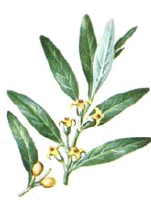
HORSERADISH-TREE (Moringa oleifera), in the family Moringaceae, is an East Indian species grown as an ornamental in southern Florida. Leaves deciduous, alternate, bipinnately (sometimes tripinnately) compound, to 2 feet long. Fragrant, white flowers about 0.8 of an inch across, in clusters 4 to 8 inches long. Capsules 7 to 14 inches long; cooked and eaten when young. Roots have horseradish odor and taste. To 30 feet tall.

SMALLFLOWER TAMARISK (Tamarix parviflora) and the smaller Five-stamen Tamarisk (T. pentandra), in the family Tamaricaceae, are native to the Mediterranean region. Branches graceful, slender; foliage small, scalelike; pink flowers in clusters 1 to 1.5 inches long. Shrubs or small trees, to 15 feet tall.
